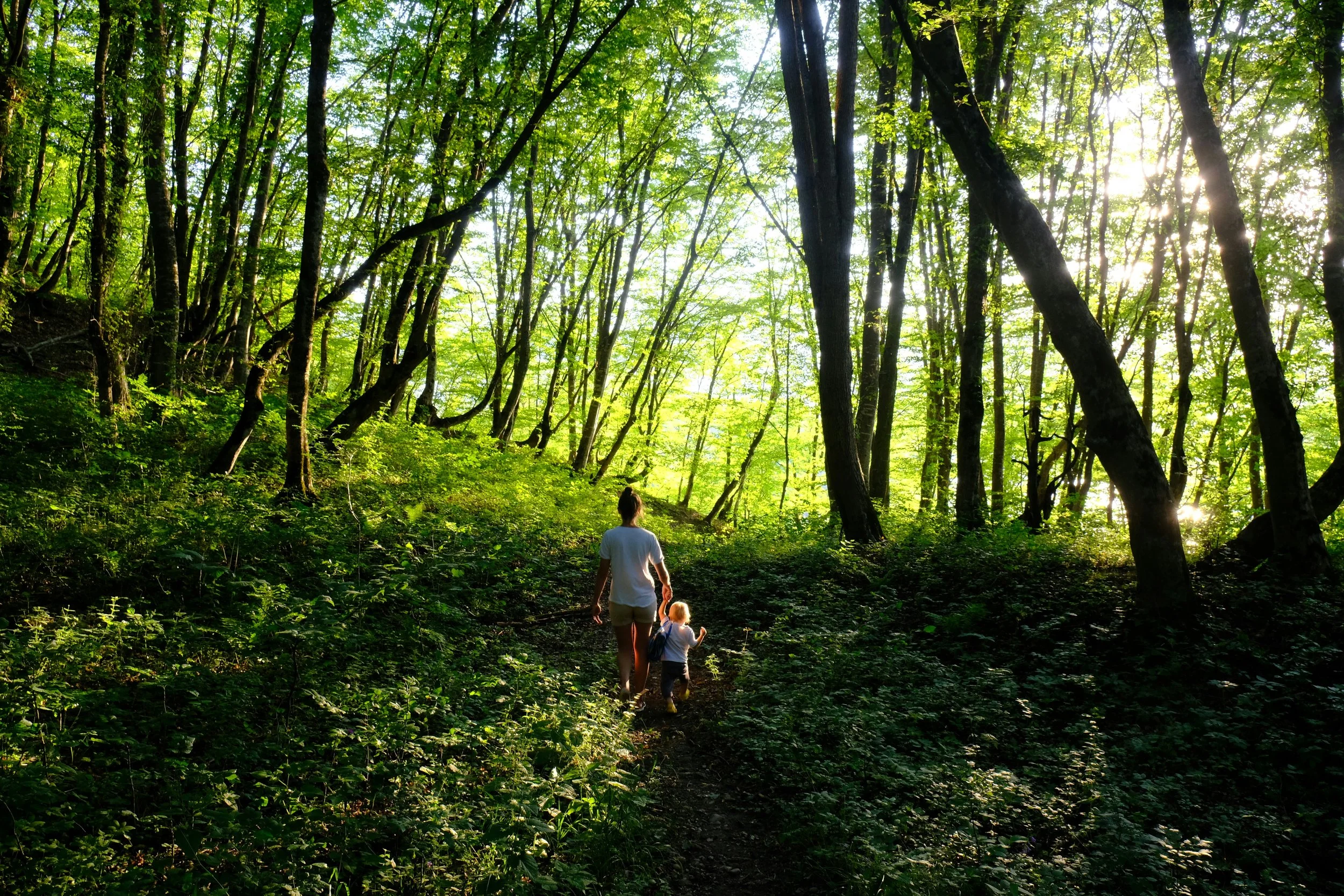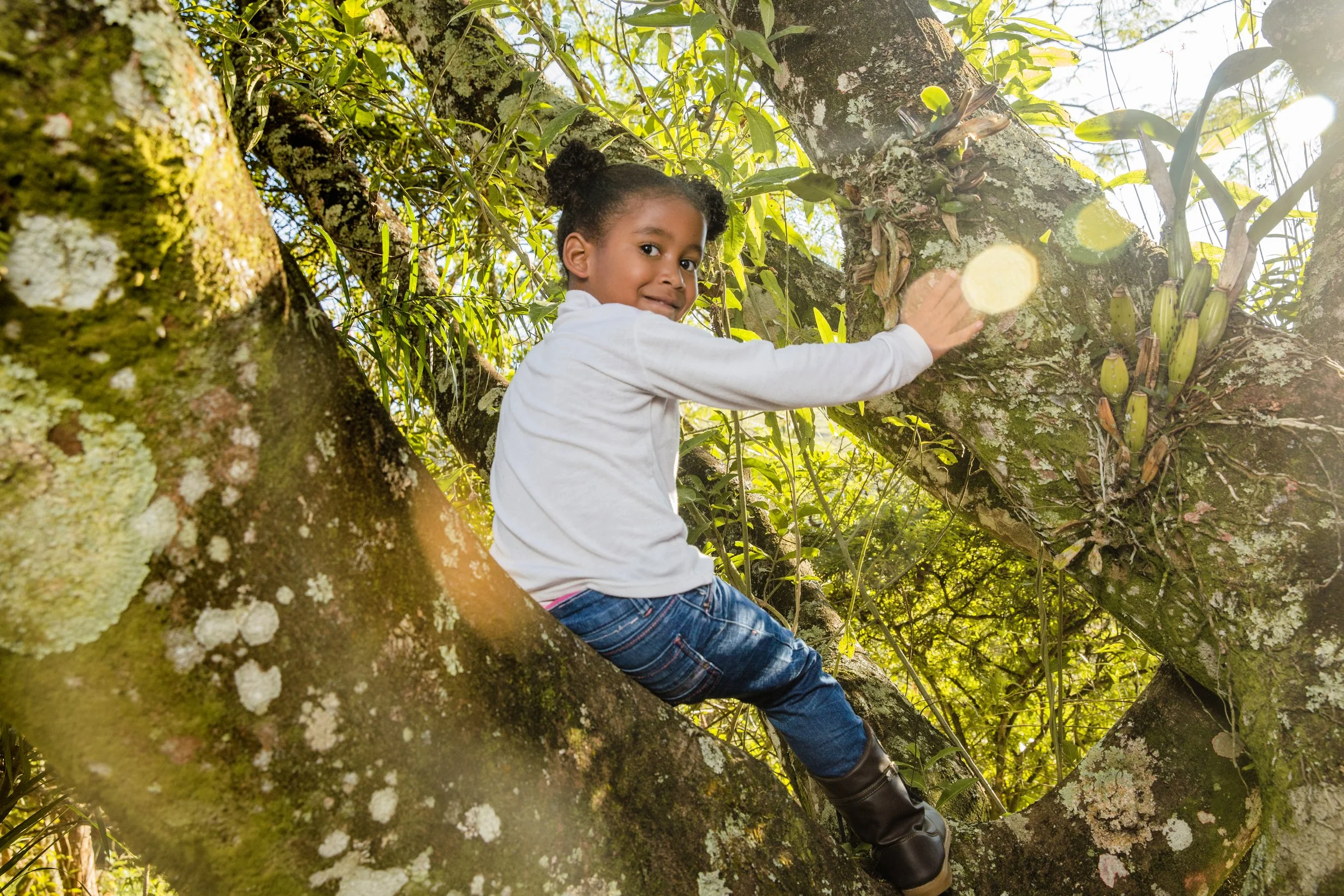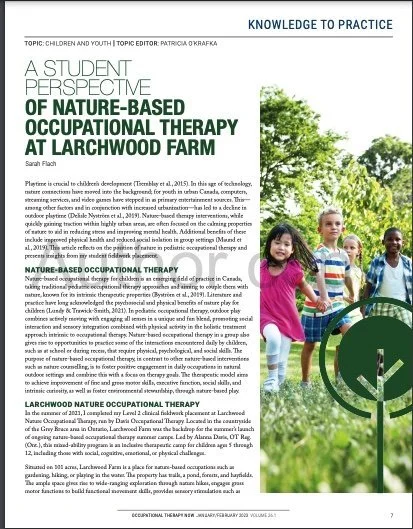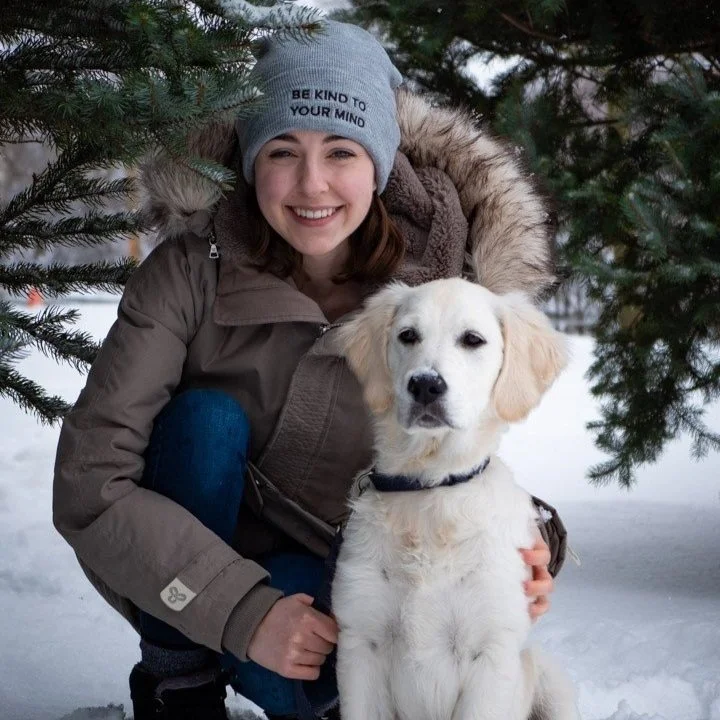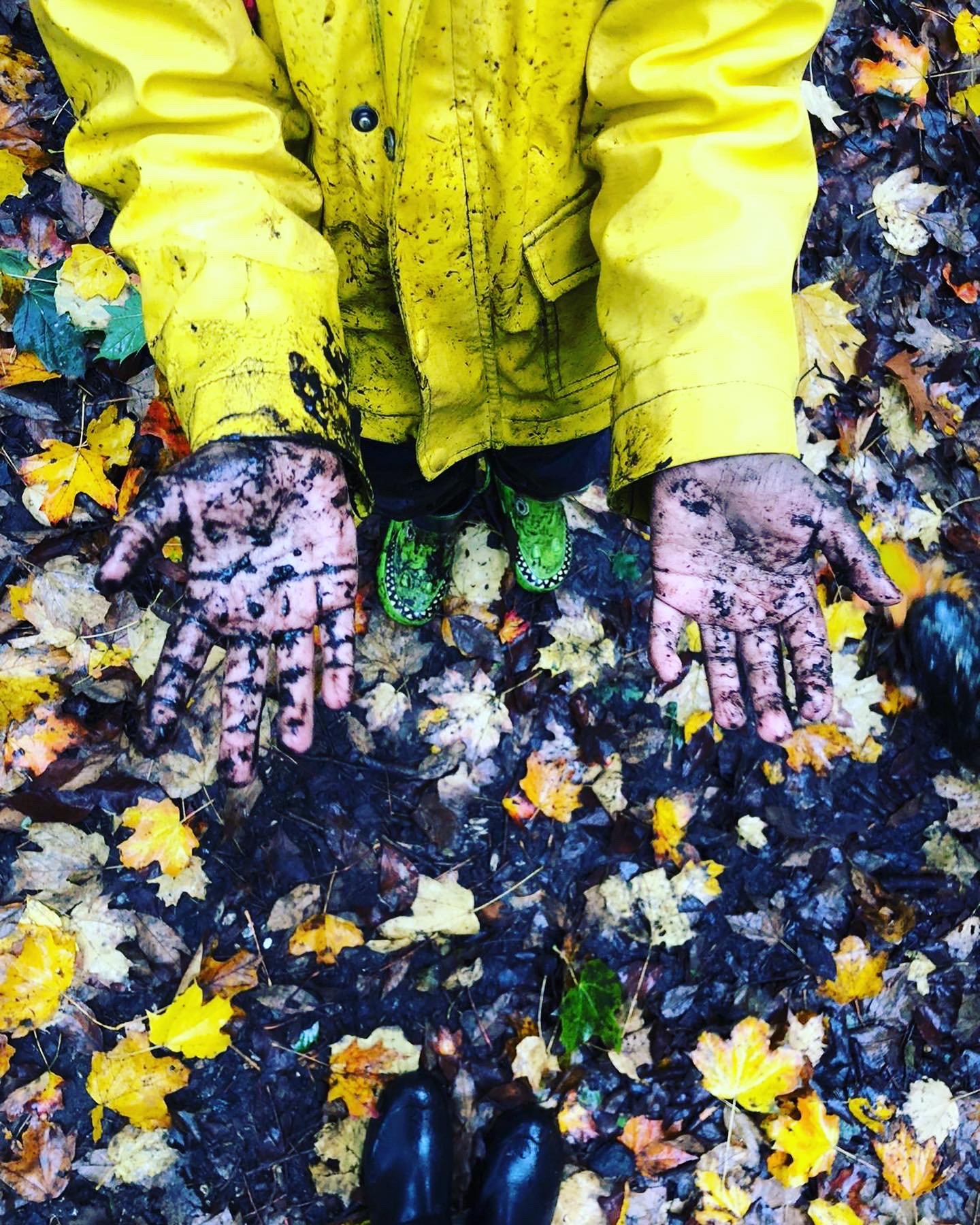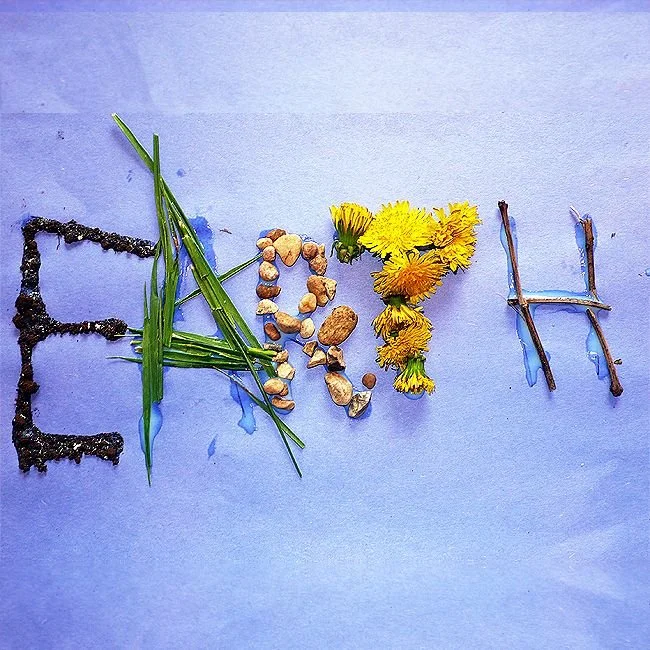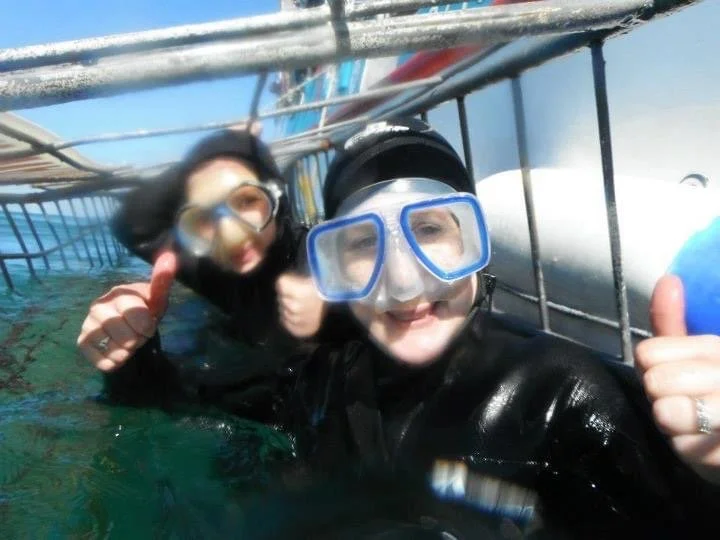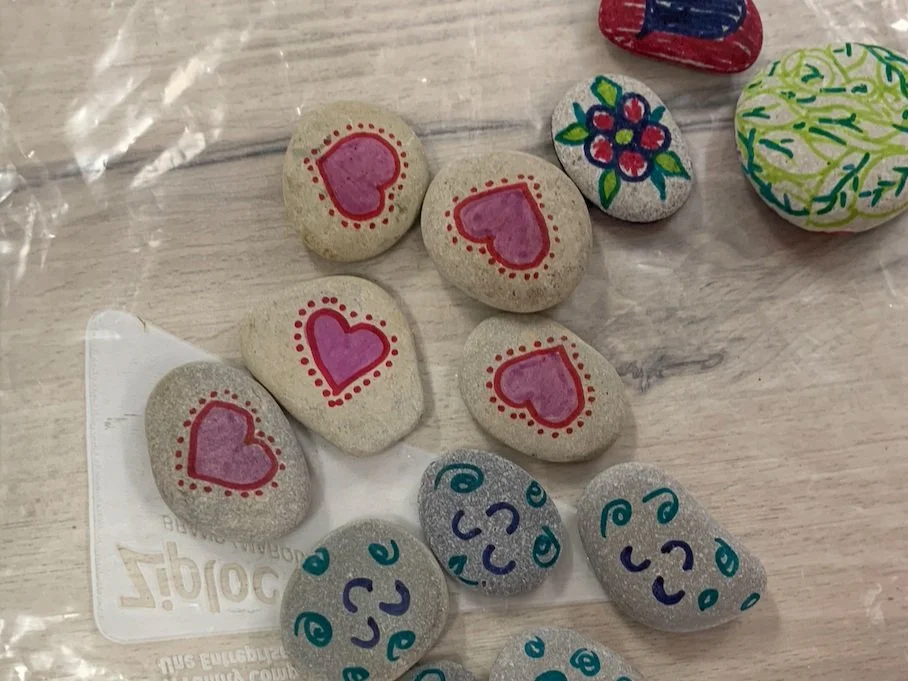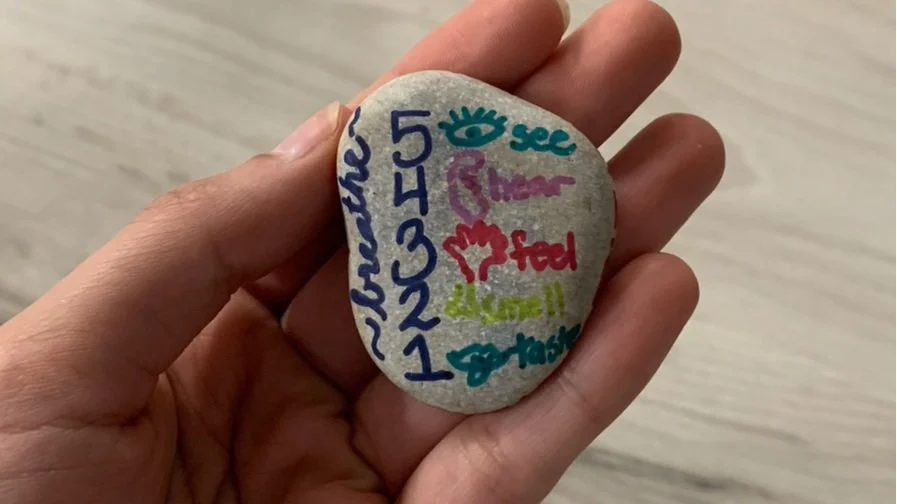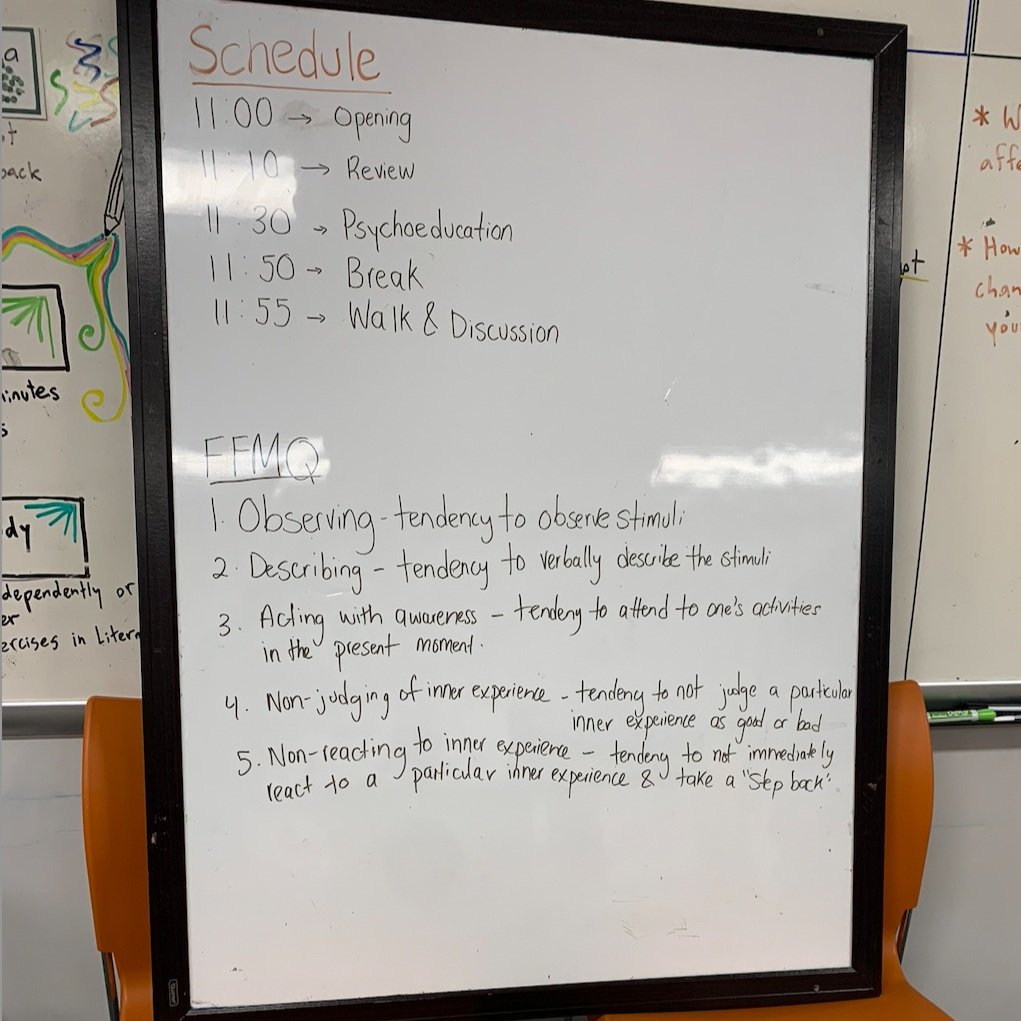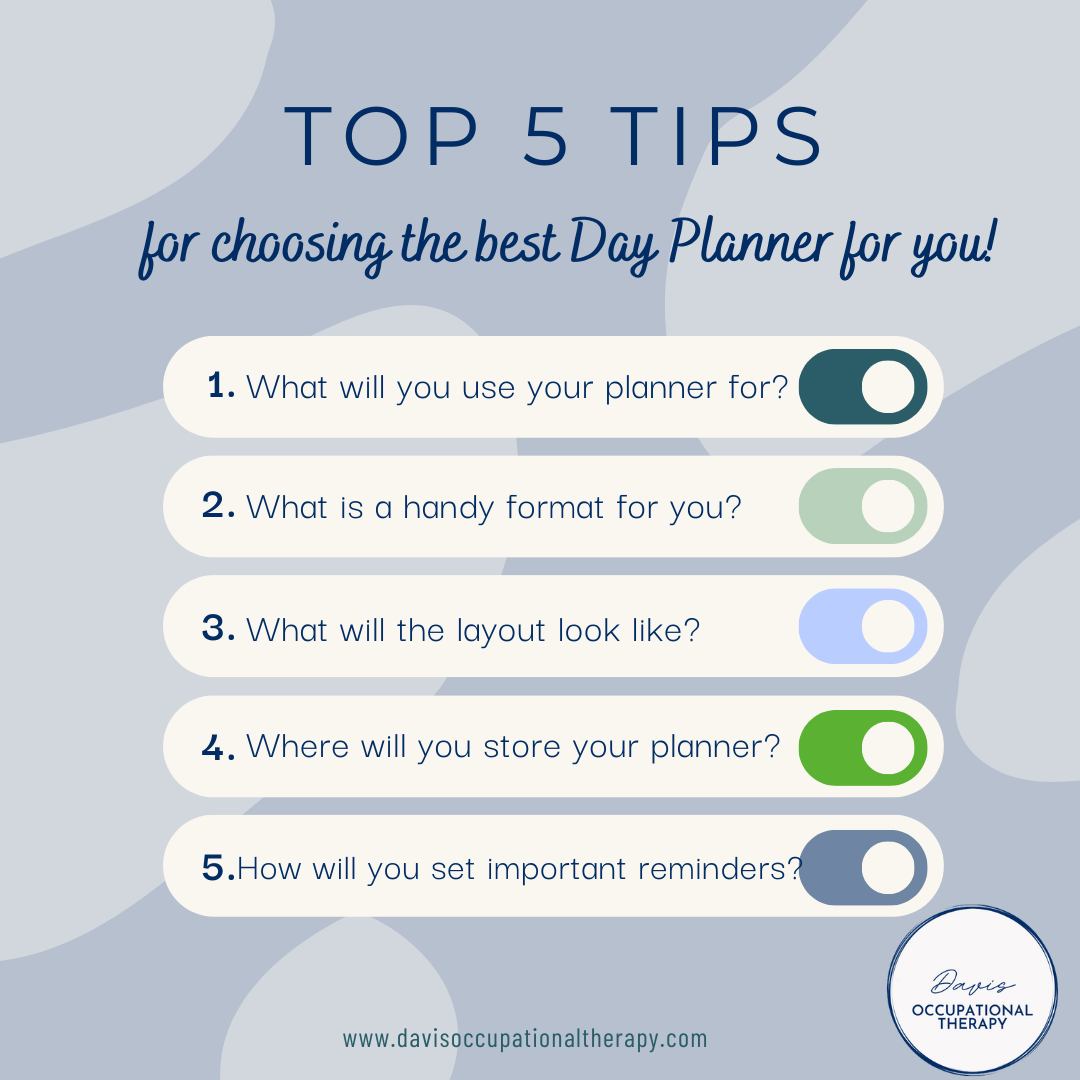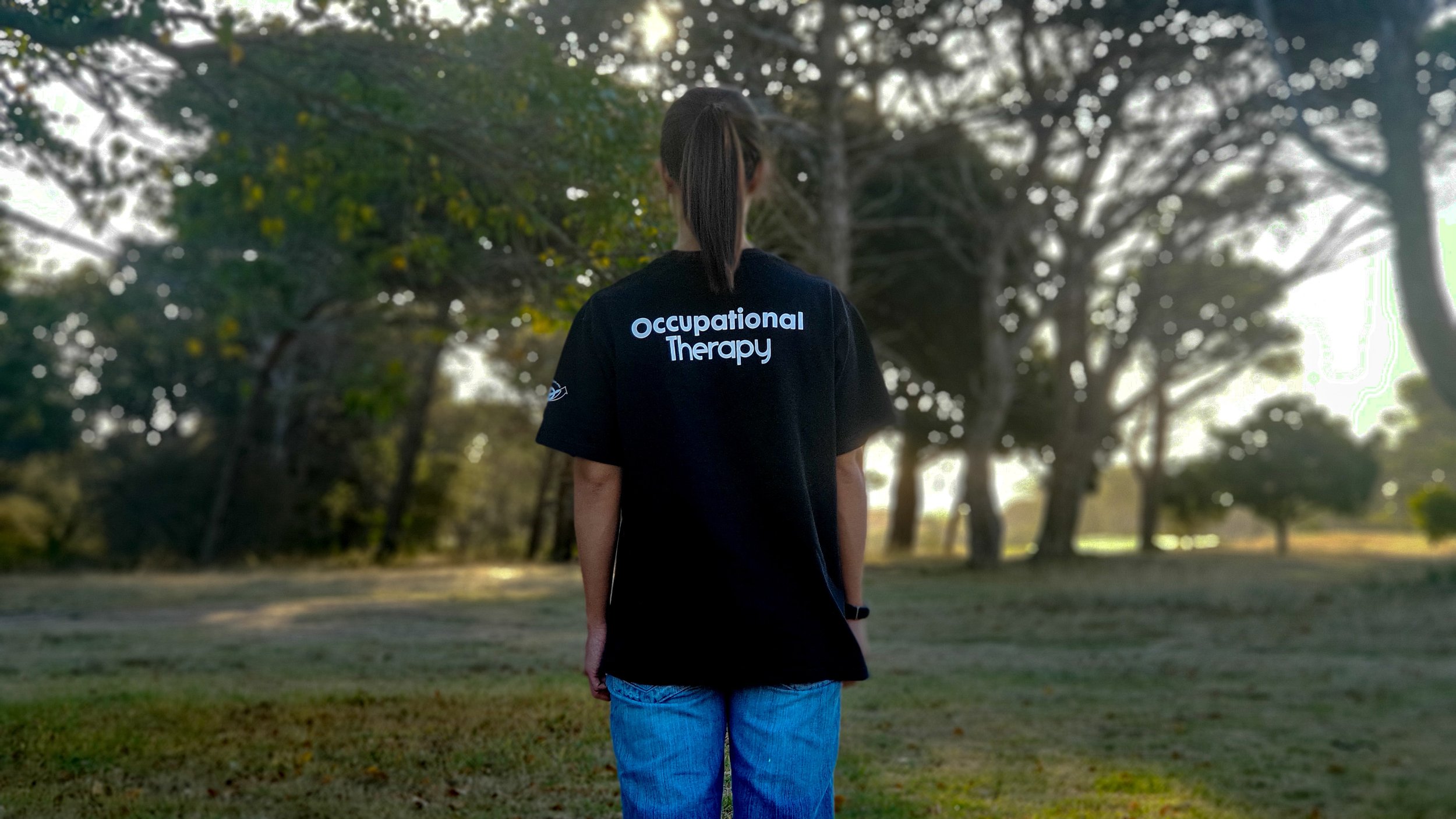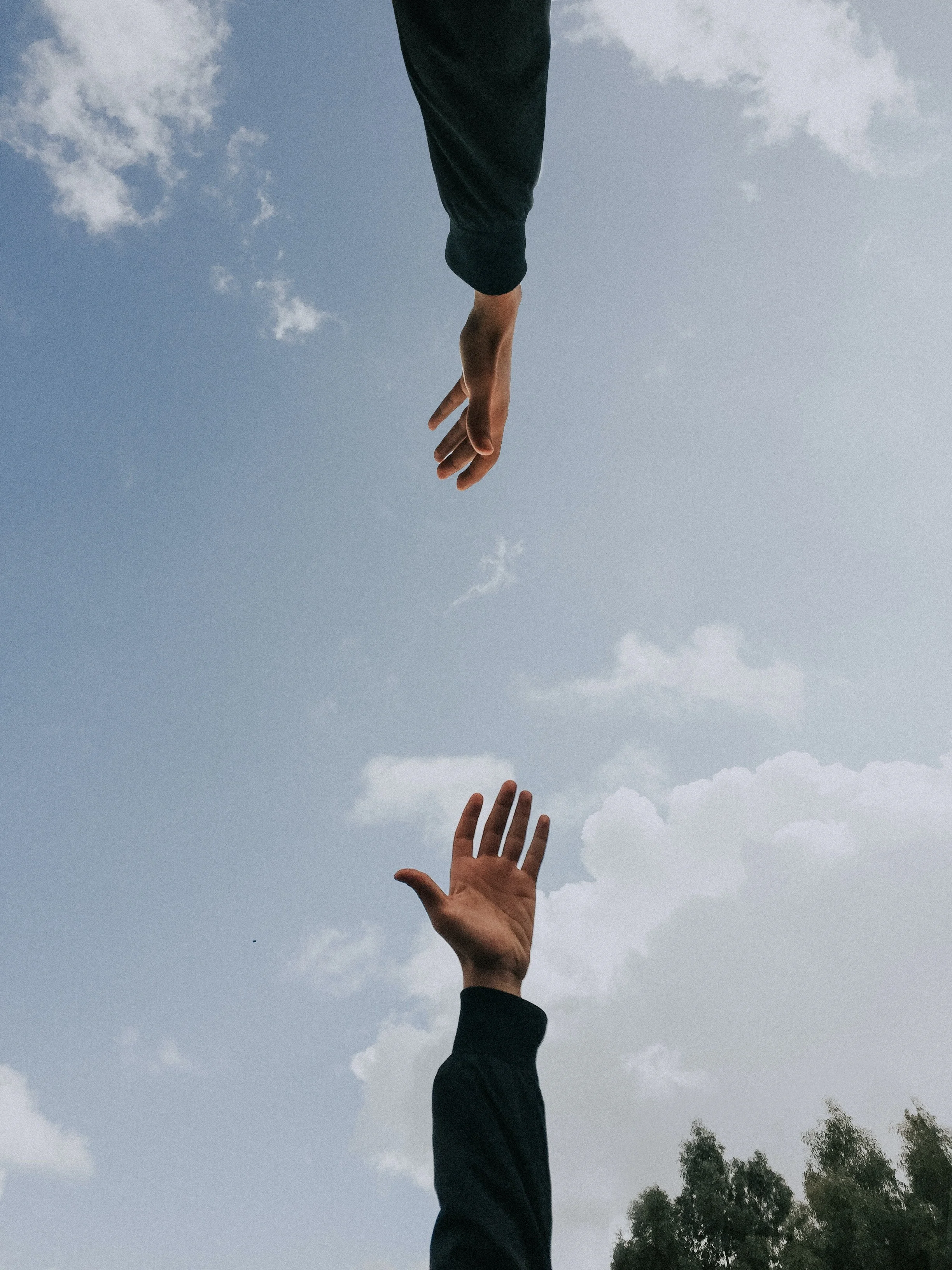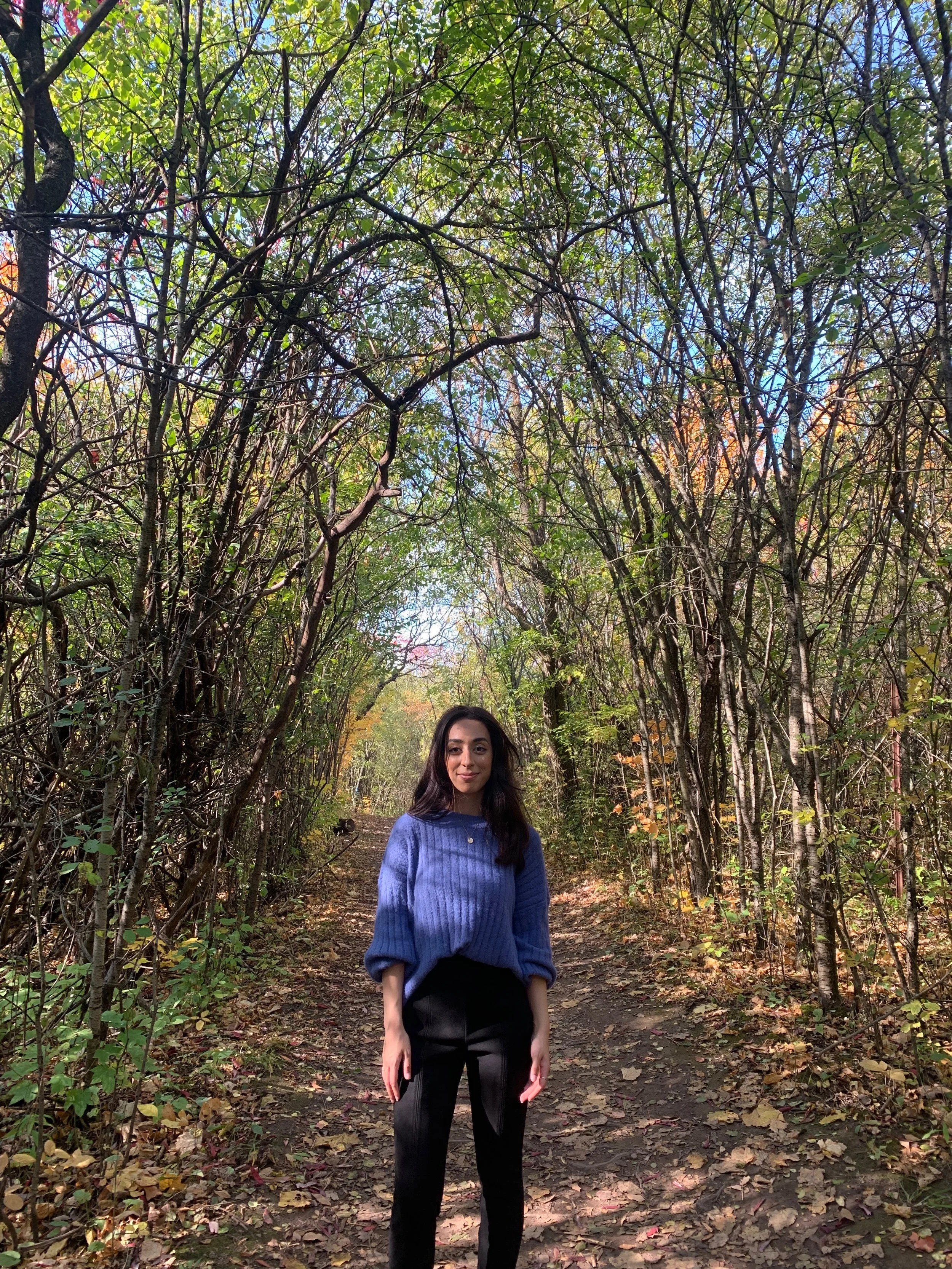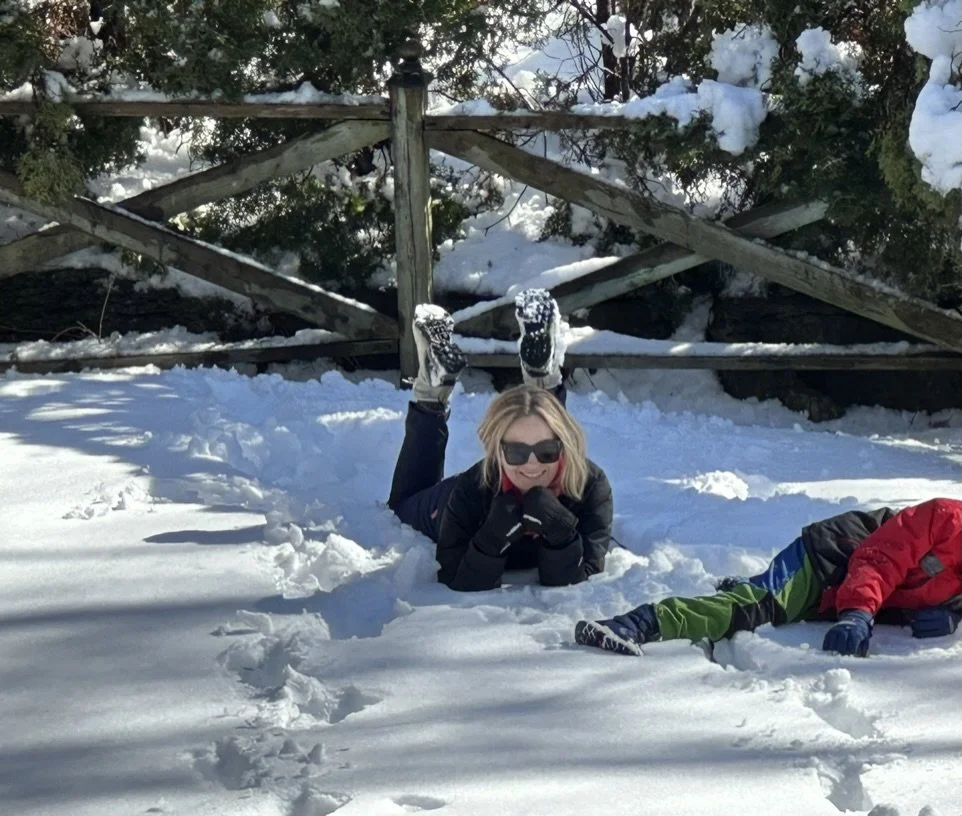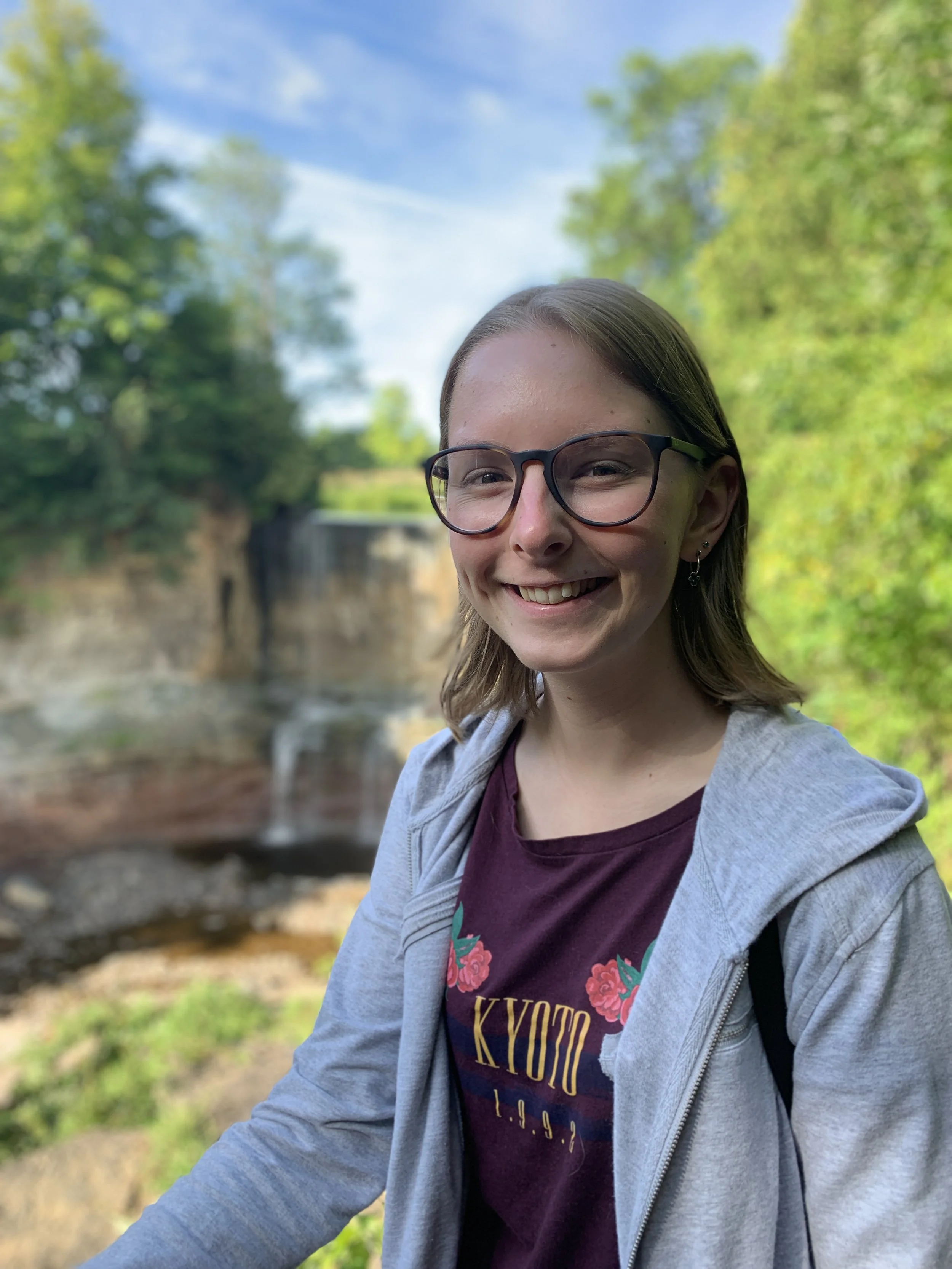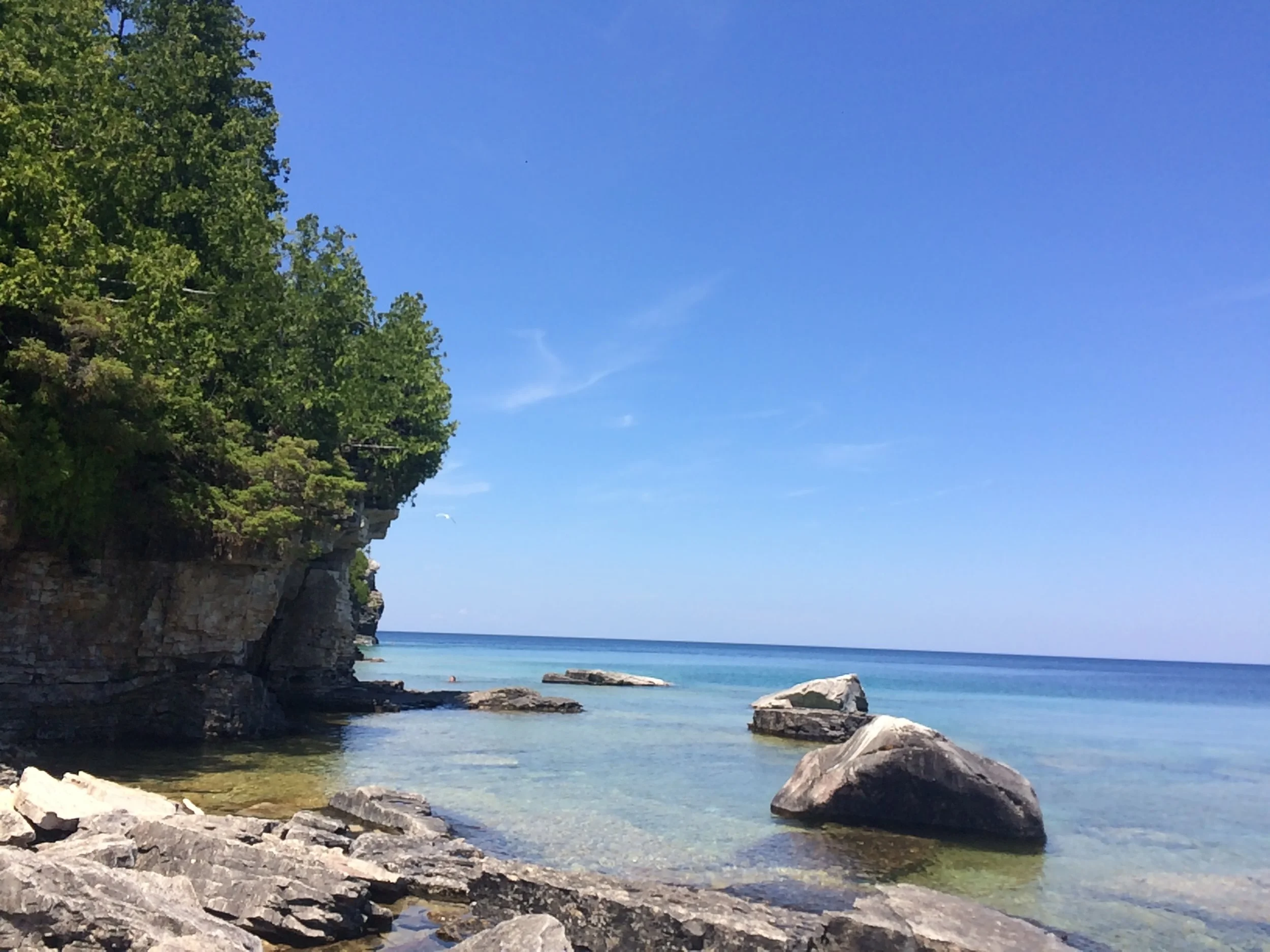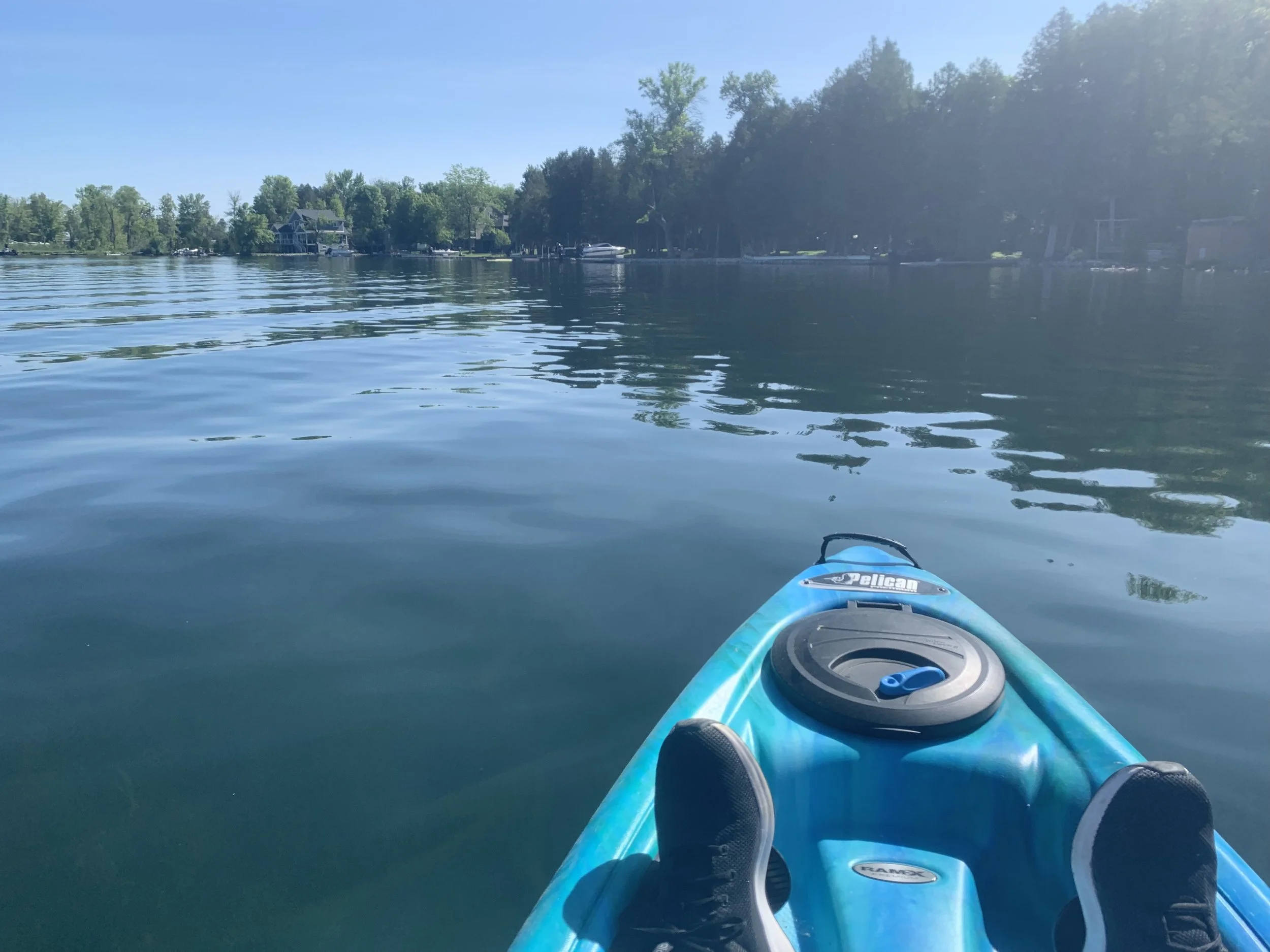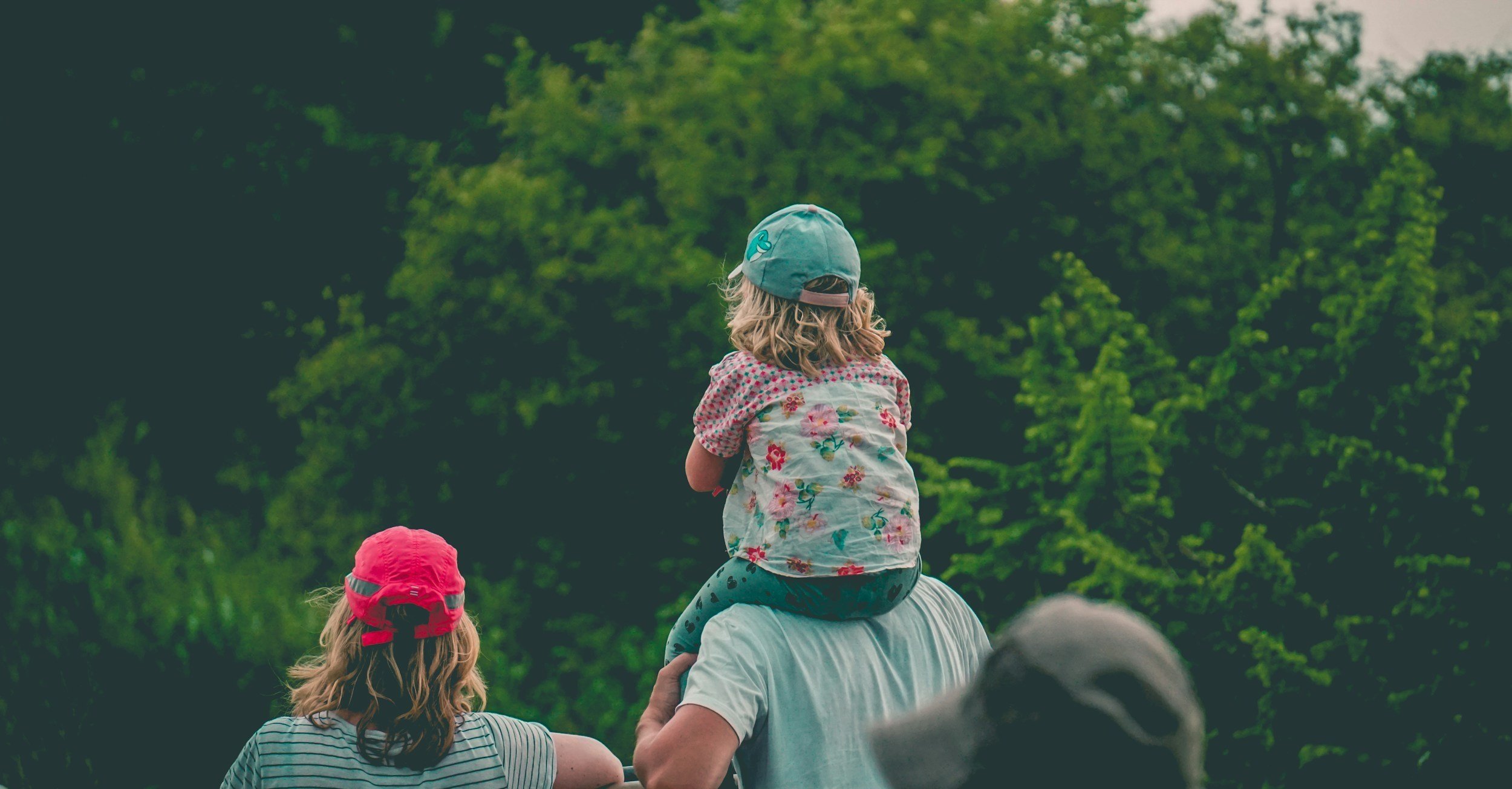
Larchwod Blog
How Forest Bathing Can Connect Your Family with Nature
The interchangeable definition of shinrin-yoku is “taking in the forest atmosphere”, which applies to our human senses. We can take in the forest atmosphere by connecting what we see, hear, taste, smell, and touch in a forest environment. Check out how you and your child can practice taking in the atmosphere by using the scenes as a natural guide!
Small child and parent walking hand in hand through a woody forest trail.
My Passion for Nature-Based Therapy
Hi! My name is Sana Majeed and I am a Student Occupational Therapist from the University of Toronto. I am currently completing my Masters Degree in Occupational Therapy and have the pleasure to be on my fieldwork placement at Davis Occupational Therapy. I knew I wanted to have a learning opportunity at Larchwood Farm Nature Occupational Therapy Camp as my personal interest of spending time in nature, such as hiking, is combined with my passion for occupational therapy. As a student, I continue to learn about the various areas occupational therapists can provide support in, and I have been fascinated with the field of nature-based occupational therapy. I especially enjoyed the many nature walks at Larchwood Farm, as I saw how it positively impacted staff and campers’ physical and mental well-being. After camp concluded, I continued thinking about ways in which we can engage with nature outside of camp. Forest Bathing, also known as Shinrin-yoku, is a Japanese term that I heard often spending my childhood in Japan. However, I did not know how to implement forest bathing in my personal life. After the 2025 Larchwood Farm Nature Occupational Therapy Camp sessions concluded, I wanted to learn more about nature-based therapeutic practices, such as Forest Bathing.
What is Forest Bathing?
In the 1980s, Japan coined the term “Shinrin-yoku (森林浴)” which translates to “forest bathing” or “taking in the forest atmosphere” to tackle the challenges of urbanization and technological advancements. Increases in work hours and exposure to urban environments has led to increases in stress-related illnesses. The Japan government initiated research studies to explore the health benefits of spending time in a forest environment. The results found a reduction in stress and blood pressure while boosting the immune system and mood. Based on the findings, it became evident to Japan that forest bathing can be utilized as preventive healthcare and could have a positive impact on an individual’s health and well-being. While the Japanese Government has funded designated forest bathing trails and centres across Japan, Forest Bathing continues to be internationally recognized for its benefits.
How to Practice Forest Bathing?
In wanting to know more about how Forest Bathing has been implemented in Canada, I connected with Anne Robillard an Occupational Therapist, Forest Therapy Practitioner, and founder of Wild Results to learn more. Wild Results is located in Calgary, Alberta and is an Outdoor Healthcare Practice which fuses nature-based occupational therapy, forest bathing, and forest therapy.
The interchangeable definition of shinrin-yoku is “taking in the forest atmosphere”, which applies to our human senses. We can take in the forest atmosphere by connecting what we see, hear, taste, smell, and touch in a forest environment. While Forest Bathing can be practiced without a guide, Forest Bathing sessions with a certified guide can offer a different experience. Guided experiences involve a “Standard Sequence'“ designed to integrate various nature-connection activities. Together, Anne and I created a list of different activities you and your child can use to engage your senses in a fun way!
You and your child can practice taking in the forest atmosphere by using the senses as a natural guide:
Vision: During your walk, play a scavenger hunt game with your child by identifying natural objects in the outdoor environment that are different colours. Keep track of colours by using the colours of the rainbow, practice turn-taking by sharing objects you see that are different colours, and looking for natural objects that have multiple colours such as a mushroom!
Hearing: At the beginning of your walk, ask your child to make a fist with their hand. Have them lift a finger once they hear a sound in the outdoor environment such as a bird chirping. For every new sound your child hears, they lift a finger up. At the end of your walk, you can check-in with your child to count how many different sounds they heard!
Taste: Use plants that are safe to eat and that have distinctive properties such as fresh mint leaves for smelling and tasting. For tasting, this can happen when you have finished your walk by tasting tea that has steeped in a thermos.
Touch: For trees that have an interesting patterns, feel the unique bark patterns with your fingers and the inside of your palm. Encourage your child to feel the natural elements with different parts of their body such as brushing pieces of grass on their arms. If your child enjoys climbing and grounding (walking barefoot on the ground) themselves, they can walk on soft patches of grass with their feet!
Smell: Look for flowers to smell along the trail. You can also ask your child to place the tip of their finger in soil if they are curious! Another fun idea is to create a smelling bowl. Ask your child to look for something they are curious to smell such as a leaf or flower and tear the pieces in your palm. Rub and squish the pieces in your palm to release their scents. Cup your hands together to then smell the natural element. Check out the Instagram page for Wild Results to visually learn how Anne creates a smelling bowl!
You can also practice using your other senses such as interoception, proprioception, and vestibular.
Interoception: Together take a deep breath and notice how the belly rises. Doing body scan meditiation involves moving awareness from body part to body part. Start at your toes and make your way to the top of your head! Provide gentle reminders if your child’s attention shifts away.
Proprioception: During your walk, if you and your child found big rocks or parts of trees, pull or push bigger items along the way!
Vestibular: Look for different trails such as steep or narrow paths to walk up and down. You and your child can also climb or balance on various sizes of logs or tree stumps!
If you are interested in Nature Occupational Therapy and would like to learn about the services we offer, book a discovery call by emailing Emma.
Helpful Links
Getting in Touch with the Senses!
A review of different sensory resources for children with sensory processing disorder (SPD)!
Exploring Sensory Resources for Children with Sensory Processing Disorder
Children with sensory processing difficulties struggle to take in and respond to sensory information. This can make self-regulation tough, leading to emotional outbursts or avoidance behaviours. Sensory processing disorder (SPD) can show up in different ways: over-responsivity, under-responsivity, or unpredictability to sensory input. These challenges can significantly affect daily life, social interactions, emotional regulation, and motor skills. Everyday tasks like dressing, feeding, and toileting may become challenging. Yet, there are many resources available to help children with SPD thrive!
What are Sensory Gyms?
Image by Freepik
Within pediatric occupational therapy, sensory gyms are structured therapeutic environments that help children with SPD to grow and develop their senses. These spaces enable children to use various gym equipment to enhance their skills in the following areas:
Sensory Integration/Regulation
The primary target area of sensory gyms is to address sensory needs. We often learn about the five senses (sight, taste, smell, touch, hearing), but there are actually eight! The additional three senses are considered foundational to address within sensory gyms.
Touch (Tactile): Sensory gyms are a great opportunity to explore different textures and materials to support sensory regulation (e.g., sensory bins filled with various materials, ball pits, textured climbing structures). It can also assist in the desensitization of touch through exposure so that children who have heightened touch sensitivity can become more comfortable and build tolerance to different textures.
Movement (Vestibular): Otherwise known as the balance and coordination sense. Sensory gyms can help children with SPD develop their movement sense by offering sensory gym equipment like swings, trampolines, and zip lines, to provide a range of vestibular input. Different movements can support sensory regulation based on each child’s needs.
Body Awareness (Proprioception): This sense helps to understand and control one’s body position and movement. Sensory gyms can provide deep pressure and heavy work activities (e.g., rock climbing, carrying a therapy ball, crashing into a soft pad) to support one’s body awareness and self-control.
Motor Skills Development
Sensory gyms can also target gross motor skills through physical activities (e.g., climbing, swinging, jumping) using specialized gym equipment like swings, rock climbing walls, and trampolines. These activities build essential motor skills for everyday activities. Fine motor skills can also be targeted through sensory gyms by interacting with hanging toys and sensory boards to support hand-eye coordination, dexterity, and small muscle control.
Social Interaction
In these spaces, children can work with peers who share similar needs to achieve common goals. Children practice key social skills like turn-taking, communicating with others, and gaining confidence in group settings.
Emotional Regulation
As sensory gyms support the sensory regulation of children, this can have a beneficial impact on their mood and support their overall engagement in different activities.
Nature as Outdoor Sensory Gyms
Image by Freepik
Nature-based therapy takes place in unstructured outdoor environments that depend on the multisensory elements of nature to provide therapy. These environments can include forests, parks, gardens, farms, and ponds. An occupational therapist will facilitate various activities in nature, from nature walks to gardening to unstructured play, while also targeting the areas that would be addressed in sensory gyms. Yet, instead of relying on gym equipment to target developmental areas, nature-based therapy is focused on utilizing nature to provide calming sensory input and promote physical activity.
For a child with SPD, nature-based therapy offers a multitude of sensory experiences that can diversify their interactions with their environment and improve their sensory processing. The natural environments also tend to be less overwhelming than urban environments, reducing sensory overstimulation and having a calming effect on their emotional state. The therapeutic opportunities in nature can target so many developmental areas! An example of a therapeutic activity in nature-based therapy can be doing a scavenger hunt during a nature walk. This type of activity targets tactile input (touching natural items like leaves, pebbles, insects), gross motor skills (walking, climbing rocks/trees), visual/auditory input (listening to the wind, birds chirping, natural light), social skills (working with others in a group to find the items), and more!
Here is an example of a scavenger hunt that we did in one of our camp sessions this year!
Another key component of nature-based therapy is risky play. Risky play is a child-led approach that builds resilience and confidence. The occupational therapist facilitates a supportive environment for the child to explore nature and make their own decisions through engagement in challenging activities—for example, rough-and-tumble play, climbing over a creek, or playing with water. While there is uncertainty and potential for physical injury, the occupational therapist is present to guide the child through healthy risk-taking.
Image by Freepik
Bringing Nature Indoors!
Getting in touch with nature while living in the city can be a challenge. However, creating a “nature nook” at home, where you foster a space for natural elements, can be a piece of cake! A “nature nook” can be individualized based on the sensory needs of the child. It also does not need to take up a lot of space. The key is to find a comfortable spot that incorporates natural elements to encourage self-regulation. It is important that the nook targets the senses, matching the sensory needs of the child.
Collecting and displaying plants, allowing natural light to flow in, and creating nature-themed art for For visual input, use plants, natural light, and nature-themed art. To address auditory needs, you can play recordings of natural sounds like rain, waves, or birdsong. For tactile input, include materials like soft wool blankets, wooden objects, or a small bowl of smooth stones to touch and hold. Creating sensory bins with natural items can also foster tactile input. The goal is to provide a rich, multi-sensory environment that helps to calm a child's nervous system when they feel overwhelmed.
Image by Freepik
Creating a Sensory Diet
A sensory diet helps identify a child's sensory needs and suggests specific sensory-based activities. Typically prescribed by an occupational therapist, a sensory diet is an individualized plan aimed at improving sensory regulation and addressing SPD. Completing a sensory profile questionnaire helps create a sensory diet. Parents or guardians fill this out with guidance from an occupational therapist, who reviews the results to develop a personalized plan. The goal is to enhance daily engagement and support self-regulation in multi-sensory environments.
Are you interested in learning more about Nature OT? Sensory Diets? Or about our nature groups? Book a discovery call today!
References
Why nature is so good for our kids
In today’s society we are seeing children and adolescents spending their time indoors on screens and electronics with less time spent outdoors. With the shift to online learning for many students, this has only increased time spent indoors on screens. Experts report that with excessive time spent on screens it can negatively impact children’s physical, mental and social health. The good news for parents is that the solution is right outside your window!
Nature provides so many positive outcomes for children and their development. Research shows that for children, exposure to nature can:
Improve mental health and mood while reducing stress and anxiety
Promote resiliency through ‘risky play’ children learn their own comfort level and build their confidence when they accomplish new tasks
Boost cognitive function as nature promotes better concentration and allows children to be creative
Develop social skills by making friends, socializing and problem solving
Enhance sensory development with providing an array of sensory experiences such as animal sounds, the feeling of grass between your toes or the balance required to stay upright when a wave hits you.
A student perspective
In 2022, Sarah Flach joined our team as a MScOT student in her first year at Western. She lived at Larchwood Farm for the duration of her 8 week placement and was integral to our launch of the Nature OT Camp! During her time she worked on writing this article for the journal: Occupational Therapy Now. Her article was featured in the Jan/Feb 2023 Issue, Volume 26.1. Click on the image to read her reflection!
She’s Social, But It’s Exhausting: Understanding Autism in Girls
One of the primary features of autism is social communication differences. Autistic children are thought to have difficulty with back-and-forth conversation, non-verbal communication, and forming and sustaining relationships. However, most of our understanding of autism is based on research done with boys (Hull et al., 2020). We now have more information about how autistic girls can experience social interaction differently.
At Larchwood Nature OT, we decided to take a closer look at what these differences are. We also wanted to see how we could better support autistic girls within our programs. In this post, we’ll share what we learned and how we plan to use this information.
First, A Note on Language
At Larchwood we are committed to a neurodiversity affirming approach. Social skills training is a phrase that pops up a lot when looking as social programs. We have found that social skills training can have a negative meaning. These programs may involve teaching the proper way to respond to others. Many of these programs can be training how to act neurotypical and this is not in line with our philosophy. We have decided to use the phrase social emotional learning (SEL) instead. This term better captures our approach of learning about our emotions and respecting our differences in social communication.
What are the Differences?
Near, Not With
Autistic girls difficulties can be harder to notice because they tend to have better social skills than autistic boys (Goh, n.d.).
Researchers have learned a lot through observing autistic children with their neurotypical peers. It is clear that autistic boys and girls can have different ways of interacting. While boys tended to play alone, autistic girls would hang out near other peers. They would jump between peer groups and briefly interact in activities (Attwood & Garnett Events, 2018). While they would be involved, teachers and parents express that the depth of their friendship connections may be superficial and one-sided (Goh, n.d.; Autistic Girls at School, n.d.).
Three girls sitting next to each other on the grass.
Greater Ability to Blend
Another thing of note is that girls seem to have a greater ability to mask their difficulties. They may have more cognitive resources, or feel more of a need to mask and conform to the group (Autistic Girls at School, n.d.). Autistic girls have expressed that they observe and imitate behaviors of peers (Goh, n.d.). This can often mean that, to the untrained eye, they do not need support which we know is not true (Goh, n.d.).
Internalizing Problems
This masking is not without consequence. For autistic girls, interaction can be mentally draining. Interaction involves processing many different things at once which takes up energy (Autistic Girls at School, n.d.). An autistic adolescent girl expressed how she always had to be careful of what she was saying because she may slip up in conversation (Tierney et al., 2016). This constant masking and ignoring of internal states can cause emotional exhaustion (Tierney et al., 2016). It has been linked to increased rates of depression and anxiety in autistic girls (Hull et al., 2020).
Why the Differences?
Children tend to interact in same-gender peer groups (Dean et al., 2017). Boy peer groups tend to be more activity based like sports games (Dean et al., 2017). Girl groups are instead more based on social communication and connection (Dean et al., 2017). This means that social communication difficulties may be more noticeable among girl groups (Dean et al., 2017).
What Can We Do?
Group of children playing with a rainbow parachute
We want autistic girls to tune into their feelings to be able to advocate for their needs. As such, the first step is to strengthen the sense of interoception. Girls need to be able to identify what they feel in their body (interoception) and the associated emotion to know what they need. We also want to help develop a variety of strategies to respond to their emotions. Once they are able to tune into their emotions, they need to be able to advocate for their needs. This means we would want to help them identify their preferences when it comes to communication, environments, etc. Then they need to feel empowered to communicate these needs. This can look like telling a peer that they would prefer to play a different game instead of neglecting their preferences to appease others. The ability to advocate is not easy! We would want to practice this several times to increase confidence in using these skills.
At Larchwood, we are working to develop a program suited to the needs of autistic girls. Join this email list to stay informed of updates relating to our new group coming Fall 2025.
References:
Attwood & Garnett Events. (2018, November 22). Social camouflaging in girls on the autism spectrum: a peer-reviewed study by Lizaan Schwartz, Provisional Psychologist. AttwoodandGarnettevents. https://www.attwoodandgarnettevents.com/blogs/news/social-camouflaging-in-girls-on-the-autism-spectrum-a-peer-reviewed-study-by-lizaan-schwartz-provisional-psychologist
Autistic Girls at School. (n.d.). Common Challenges at School: Peer Relationships. Autistigirlsatschool. https://autisticgirlsatschool.com.au/CommonChallenges/PeerRelationships
Dean, M., Harwood, R. & Kasari, C. (2017). The art of camouflage: Gender differences in the social behaviors of girls and boys with autism-spectrum disorder. Autism, 21(6), 678–689.
Goh, S. (n.d.). The Girl Gap: How Autism Manifests Differently in Girls. CorticaCare. https://www.corticacare.com/care-notes/autism-in-girls
Hull, L., Petrides, K. V., & Mandy, W. (2020). The Female Autism Phenotype and Camouflaging: a Narrative Review. Review Journal of Autism and Developmental Disorders, 7, 306-317.
Tierney, S., Burns, J., & Kilbey, E. (2016). Looking behind the mask: Social coping strategies of girls on the autistic spectrum. Research in Autism Spectrum Disorders, 23, 73-83. https://doi.org/10.1016/j.rasd.2015.11.013
A Day at the Farm: Our Neurodiversity-Affirming Summer Camp
We are so excited for our upcoming Larchwood Farm Nature Camp sessions. This is our 5th summer welcoming children, ages 4-12 years, to join us in week long sessions. Our camp is nature-based with a focus on creating a neurodiversity-affirming environment where we celebrate campers' strengths and build on their interests. Camp is led by a spectacular team of Regulated Health Professionals, including Occupational Therapists and Social Workers.
Camp Goals
The goals of Larchwood Farm Summer camp include:
Improving gross motor skills including coordination, strength, and balance
Developing executive functioning skills including problem-solving, planning, and organization
Developing socioemotional skills through cooperative play, sharing stories, modeling and practicing emotional regulation
Building curiosity and nature connection
Typical Day at Camp
Opening Circle
The opening circle is our opportunity to set the stage for a great day! We provide a prompt during our opening circle that can get the children sharing. We sometimes bring a talking stick that campers get to hold while speaking. This is a great tool to support group listening, turn-taking, and self-regulation.
Yoga during our morning circle!
Nature Walks
Our mornings are spent exploring nature at Larchwood Farm! Campers will explore different trails and paths on the 101 acre property. Some days campers may be collecting items for a nature craft. We also use this as an opportunity to build on the interests of the campers! Nature walks are a great opportunity to practice gross motor skills like balancing on logs, crouching under branches and pushing through tall grasses.
Arts and Crafts
Campers carved their names into wood with the help of our amazing staff!
We have a collection of creative activities that we have accumulated throughout the years. Through art projects, our campers connect with nature while practicing fine motor skills, executive function, and more.
Campers also build communication skills as they work together on masterpieces. Building boats allows for the children to observe each other’s creations, noting which ones floated and which did not.
Lunch and Structured Free Play
We simultaneously hold lunch time and structured free play as some campers may not be ready to eat while others are. We have snack times throughout the day to make sure all our kids have the opportunity to eat when and if they wish to.
During structured free play, we set out different items that campers can engage with. Children can build their own structures using the loose parts, follow recipes in our mud kitchen or engage in a group game. The highlight in the last few summers has been the theatre and costume bin. Many great plays have been performed under the trees during free play.
Reading books to spark discussion about emotional regulation!
Emotion Regulation Activities
At Larchwood OT, we use the Powerfully You framework to teach campers about their emotions! We do activities that help campers tune into what they are feeling in their bodies. We also use the symbol of a body battery to discuss tools for emotion-regulation.
Wilderness Activities
Building structures in the forest!
One of our goals at Larchwood OT is to foster a connection with nature. During our wilderness activities, we take the group into the forest and engage in activities that not only involve nature items but immerse us in the setting. For example, campers will challenge their executive functioning skills by searching for different kinds of trees, making maps of the landscape, and identifying animal tracks.
Active/Cooperative Play
These games have campers in teams requiring communication, problem-solving, emotion-regulation and listening. Games involve an active aspect, so campers are also building motor skills. Some of our favourites include creating obstacle courses, bucket relays at the pond on hot days and West Wind Blows!
After, we bring the day to a close as we settle down to journal and reflect on the amazing memories we made!
Throughout the week, campers engage in water play, food preparation, trips to the stream and a special visit to Firefly Ridge!
At the beginning of camp, our team conducts assessments to develop specific goals for each camper. As we engage in activities throughout the week, our highly trained staff are constantly building on activities to meet campers specific goals. At Larchwood farm we are committed to ensuring a fun, challenging, and inclusive camp for your child!
Want to hear more? Or do you have specific questions? Register for our virtual camp information night on April 30th at 7:30pm!
Registration for camp is open - spots are limited!





Pervasive Drive for Autonomy and Autism
Young child holding a paper map, studying it intently.
Our team of OTs recently met for some professional development, exploring the autistic neurotype called Pervasive Drive for Autonomy (PDA). It was a fascinating conversation, led by OTs Emma & Kristina who are seeing this presentation in more and more of their clients and families.
PDA versus Demand Avoidance
PDA is used to describe a neurotype which co-occurs with autism spectrum disorder. It results in a pattern of behaviors in which real or perceived loss of autonomy leads to an extreme stress response. When we use “Pervasive Drive for Autonomy”, instead of language like “oppositional behaviors” or “pathological demand avoidance” we are acknowledging it as a nervous system disability rather than willful behavior.
Neurodiversity Affirming
At Larchwood Nature OT and Davis OT we use neurodiversity affirming treatments and language. We are not looking to change a person or make them compliant but rather we are seeking creative ways to accommodate their disability within all their environments.
What does PDA look like?
PDA has 3 distinct characteristics:
Equalizing
Fight/Flight/Freeze
Burnout
A child with PDA will try to gain back control in situations where there is a perceived loss of control. This can be with a parent, teacher, therapist, older sibling, etc. If there is a sense of lack of control this will lead to an extreme stress response of fight, flight or freeze. Over time these responses build and result in burnout that looks like intense fatigue and the inability to participate in even the most basic activity of daily living.
How can we work with PDA?
There are a number of ways that you can support the child or adult in your life that has PDA.
Lower demands on them: This may mean shifting your expectations on what it means to be a child, parent or therapist. Demands are what triggers the nervous system to go awry so being thoughtful about what that looks like at home or in the classroom.
Provide control: Allow for choice, child-led activities and make them feel safe.
Increase recovery time: Build downtime in as much as possible to conserve energy and allow the nervous system to rest.
Want to learn more?
You can book a Parent Coaching session with OT Emma and learn so much more, plus be able to implement some new strategies.
Head to the following websites:
Check out these books recommended by OT Kristina:
In an effort to be more neurodiversity affirming, a new autistic neurotype is becoming more widely recognized. Pervasive Drive for Autonomy is a nervous system disability triggered by a person’s real or perceived lack of autonomy. The reaction to this sensation is an extreme stress response and possible burnout. It’s important for therapists, parents and teachers to understand this cycle and make efforts to accommodate their child’s unique needs.
Do you think your child or family member may have PDA traits?
Want to talk it through with an OT and try some new strategies?
Book a Coaching Session with Emma.
Understanding Your Autistic Child - Burnout, Inertia, Meltdown, and Shutdown
Read on for a blog post from our current MScOT student on understanding your autistic child(ren). Taryn describes new research about autistic burnout, inertia, meltdown, and shutdown, and how understanding these experiences can help you be a better parent.
Raising Autistic Children
Does your autistic child experience big emotions - like sadness, anger, or frustration? When your autistic child becomes overwhelmed, do they cry, yell, fight, or run away?
Parents raising autistic children may be familiar with these experiences, often called meltdowns. What parents may not know is that their autistic child(ren) might also experience burnout, inertia, and shutdown.
Burnout, inertia, meltdown, and shutdown - commonly shortened to BIMS - are ideas that were first talked about in the online autistic community. More recently, scientists and healthcare professionals have been working with autistic children, youth, and adults to understand these experiences better. Let’s break down what they’ve learned!
BIMS: Burnout, Inertia, Meltdown, and Shutdown
Burnout, inertia, meltdown, and shutdown (BIMS) are experienced by autistic people in their bodies, minds, and emotions. These experiences can make it hard for autistic children to do their everyday activities - like going to school, making friends, and enjoying their hobbies.
When researchers interviewed autistic children, they shared that most adults in their lives don’t understand BIMS. These autistic children wanted their parents and teachers to understand their experiences. They also wanted to be involved in coming up with solutions or strategies.
So, what can you do as a neurotypical parent or caregiver of an autistic child(ren)? Start by learning more about autistic burnout, inertia, meltdown, and shutdown.**
Burnout: Feeling Exhausted
Burnout can happen when your autistic child feels exhausted and completely drained. They also might feel less patient, stressed or grumpy. Burnout can happen when your autistic child has been busy with lots of different activities and responsibilities, like homework, chores, and sports.
Many autistic kids feel like they can’t be themselves at school or when around other people. They might hold in their “stims”, make lots of eye contact, or put a lot of energy into acting the way everyone expects them to. Some people call this “masking”. Not only is masking exhausting, but it may increase the chance of autistic burnout.
Watch a video on autistic burnout: https://youtu.be/o1yqzfKg37o
Inertia: Feeling Stuck
Inertia is when your autistic child feels stuck or like it’s hard to start, stop, or change activities. It can be frustrating and annoying, as they might really want to start the activity, but just can’t. Inertia can also feel like nervous energy or a tense feeling.
Watch a video on autistic inertia: https://youtu.be/ESgvWx5iasg
Meltdown: Feeling Out of Control
A meltdown can happen when your autistic child feels overwhelmed - it might be a sudden response to something happening or from a buildup of stress. Many things can cause a meltdown, like social demands, frustration, embarrassment, challenges with communication, emotional triggers, or overwhelming sensations.
During a meltdown, it can be hard for your child to tell you what they’re feeling. They may also do things they don’t normally do - which is why they feel out of control.
After a meltdown, autistic kids often feel guilty, ashamed, and embarrassed, especially if it happens at school or another public place. They also might find it hard to remember what happened during the meltdown, which makes it even harder to understand and explain it to others.
Watch a video on meltdowns: https://youtu.be/Tir4JHVqUso
Shutdown: Feeling Frozen
A shutdown can happen when your autistic child feels upset and can’t react to a situation. A shutdown can feel like having a meltdown on the inside, but it looks different from the outside. Instead of yelling or crying or kicking, your child might freeze up. Many autistic kids feel like they can’t talk or move during a shutdown. They might feel like they want to escape or just curl up into a ball.
Watch a video on shutdown: https://youtu.be/BNeDL8CzC7c
Raising autistic children can be filled with many joys and also challenges. As a parent or caregiver, you can best support your autistic child by taking time to understand their unique experiences - including if and how they experience burnout, inertia, meltdown, and shutdown.
Only once you understand these experiences can you work with your child and other members of their team (teachers, EAs, social workers, occupational therapists, etc.) to create helpful strategies and support plans.
Want to learn more?
Interested in learning more about autistic burnout, inertia, meltdown, and shutdown? Check out the website https://www.bimslab.ca/ for more information and support tools.
Hoping to discuss how best to support your autistic or neurodiverse child(ren)? Email Emma to book a discovery call and chat about your family’s needs.
**Note: Given the overlap between autism and other experiences of neurodiversity, there’s a chance other neurodivergent kids (and adults) also relate to the descriptions of burnout, inertia, meltdown, and shutdown. However, this article is based on research specific to autistic children, youth, and adults.
Author: Taryn Kieller, MScOT
Taryn is a second-year Occupational Therapy Student at the University of Toronto. As a neurodivergent person, Taryn is passionate about promoting health and well-being for all people, prioritizing a strengths-based, neurodiversity-affirming approach. In her graduate research project, Taryn helped refine and launch support tools for autistic burnout, inertia, meltdown, and shutdown (BIMS). Taryn is a co-creator of the website www.bimslab.ca.
Larchwood is Neurodiversity Affirming
Read on for a special reflection from one of our Larchwood parents. Sada describes how we can offer something different for our children, how we need to listen to understand our neurodiverse kids and how we as parents sometimes need to grieve what we thought parenting would be.
A Powerful Note from a Parent
Recently a Larchwood parent and volunteer, shared her thoughts on what sets us apart from others therapeutic group programs. She also strongly believes there is space for caregivers, educators and therapists to change the way they approach the neurodiverse kids surrounding them.
This parent has had a long journey in articulating these reflections. She is also a regulated health professional and an advocate for neurodiverse kids living in rural areas with limited access to healthcare resources. She truly inspires us each year at Larchwood Farm Nature OT Camp, sharing her parenting knowledge and experience in the kindest most applicable way so that we can continue to be the best for our campers. Sada has been with us since the first summer of camp and continues to be our biggest supporter and advocate.
Sada’s Story - The Power of Observation
“I was thinking of you and the camp yesterday and how I always ask that we ease up on expectations - that it isn't our right to set the expectations but to watch the kids and try to understand where they are at - setting the goals together and that informs our expectations.
The Challenges in the Public School System
C's (Sada’s youngest son) teacher grabbed me yesterday to tell me that he refused her directions - that he normally complys but yesterday he refused. I had to think about that a lot and talk to C to understand what was going on with him. My naive mom brain would think - “C, you need to apologize to your teacher and listen to her today!”
From C's view - he was overstimulated with the excitement of Valentine’s Day, a bit of extra sugar on board, also fighting a cold, up too late and at the moment of truth... he had the chance to be the "caboose" in the line. He loves having special jobs. He is very needy and quite insecure. His teacher tends to raise her voice when she is frustrated (again, who could blame her) but yelling is very triggering for C because of his trauma background.
Why is my child always saying “No”?
His refusal was his protection and that was really important to him at the time for his survival - by now his brain is offline (also underdeveloped in the prefrontal cortex from trauma during crucial development years +/- ADHD) and refusal is the most effective way to stay safe. This is very hard to explain to an educator:
"Mrs. K, you need to do better, catch the kids when they're up stream, be a detective, check in with your students. Don't raise your voice with a student, there will be more than one child who is triggered by yelling. And I promise you that C's refusal to comply wasn't the first sign that he was having an off day yesterday - so you could have predicted that he wouldn't be able to comply with strict instructions to give up his cherished caboose position.”
Maybe to Mrs. K, being the caboose is no big deal, but if she knows anything about C, she would know that he craves feeling special because of a deep wound that he carries on the inside.
At Larchwood we have the time to be more involved
I understand that in a public school with high ratios - it's almost impossible for the educator to be involved at this depth - but at camp we can be! This is how I'm trying to teach professionals to see the kids who are struggling, to understand them and meet their needs.
Shifting our Mindset
As a mom, I've had to let go of the idea of the mom that I would be. I've had to grieve that and let it go when I was ready. I think that the same thing happens professionally.
We invest in this idea of the services that we'll provide and the type of clinician that we'll be - then we get these kids on our service that don't (can't) do any of the programming that we organize even though we're sure that it's excellent programming (and we think they have the capacity). It's not about the programming, sure programming and opportunities are very important, but we'll never get to the programming if we can't meet the child emotionally where they are at. Some days will be different and we won't get our way - but that's for us to get over - it can't be a reflection of the child's success.
Does this sound like the approach you have been seeking for your own child(ren)?
Want to learn more about the services we offer?
Maybe you even want an opportunity to hear more from Sada!? Guest speaker!
Click here or book a discovery call with Emma to chat about your family’s needs.
3 Reasons Your Child Needs More Risky Play
Risky play is a hot news topic right now as yet another winter activity has come under scrutiny. Tobogganing has been banned in a number of City of Toronto parks. What are your thoughts?
What is Risky Play?
When kids experiment and push themselves in new environments, they are participating in ‘risky play’. Without knowing what will happen, they explore and figure out what will happen. They feel excited, thrilled and challenged!
Risky play has been a hot topic in the news recently as we discovered that tobogganing is banned in many City of Toronto parks. Did you also know that climbing trees is not permitted in City of Toronto parks?
Unstructured, outdoor play is key for childhood development, especially as we see growing numbers of obesity, anxiety and behavioral issues in our children.
1. Risky Play helps children discover their own abilities, limits and comfort levels!
We are encouraging children to get up and move! They are learning to assess their strength and building physical literacy. Their bodies will remember these repetitive movements and the joy that came with them - building a lifelong love of physical activity.
2. Risky Play builds immunity!
Did you know that digging in the earth, moving around barrels, logs and other loose parts is in fact good for your overall health!? It diversifies your skin and gut bacteria which is a good thing.
3. Risky Play builds self-confidence, resilience & thinking skills!
Rough and tumble play builds resilience, conflict management skills and better problem solving in kids. In a recent study, students in Grade 4 were provided with risky play opportunities for 3 months. The teachers then reported improved resilience, self-esteem and concentration in the classroom!
Parents Balance Risks & Hazards
Obviously, we are not going to allow our children to play near a busy roadway or along a rushing river. As parents we can use our developed cognitive skills to assess the risk and supervise the child based on their age and development.
At Larchwood Nature OT we believe in the value of unstructured, free play in nature. This is a key ingredient to all of our programs. We allow the children to lead, be curious and try new things. We have changed our language from “be careful” to:
“Take your time”
“I’m here if you need me”
“Do you feel stable/safe?”
“I like how focused you are!”
The 2022 Participaction Report Card gave Canadian children a grade of D overall for physical activity and a D– for active play. We need to do better! At Larchwood Nature OT we fully support risky play and families are seeing the positive changes in their children. We balance risky play with treatment in all of our outdoor sessions.
If your child has a sense of curiosity and enjoys the outdoors then check out some of our unique programs.
Supervised Risky Play Options at Larchwood Nature OT
Weekend Nature OT Group - 8 week Winter session begins March 2, 2024
Nature Play Group - Feb 17, 2024, drop by, stay for the hour, OT led, $19/child
Larchwood Farm Summer Camp - Therapeutic camp for kids 4-12 years of age!
The Dreaded "Gift Disappointment"
Holidays come with the highest highs and lowest lows. Gift disappointment can make us all feel upset and embarrassed. Here are some tips for dealing with the big emotions after a gift is opened and not appreciated.
The Dreaded “Gift Disappointment”
This info recently went out to all of our Nature Insiders on our email list. The feedback was overwhelming so I thought I’d also share it here on the blog! If you don’t want to miss out on our monthly email, click this link to go to the website and add your name & email.
My Story
My son, Alex, is quite into LEGO. This past year the more obscure and vintage the better. Not the easiest task for shopping. But last year I remember the significant gift disappointment on Christmas morning when he did not receive the very large and very expensive set he wanted. And to top it off we had no family buffer - we were snowed in for 4 whole days at the farm. JUST THE 4 OF US. It was tough and it really hurt my heart. Given his emotional maturity is still underdeveloped I sought out some advice from Dr. Nicole Beurkens, a child psychologist, and I’m sharing highlights from her podcast so we can all be prepared and ready for gift disappointment!
7 Tips for dealing with the big emotions that come with Gift Disappointment:
Please remind yourself that it does not mean your child is ungrateful or spoiled but rather it’s your child’s reaction to the feeling of disappointment.
Find a quiet, safe, regulated time to begin talking about these feelings BEFORE the big day.
Explore: Get kids thinking and talking - being prepared takes the power out of a big feeling. “What do you think it will feel like if you don’t get that Lego set you are asking for? … I was wondering how you might feel if one of your cousins gets a gift that you wanted?”
Priming: depending on the age of your child you may need to help them answer the question, name feelings, understand that 2 feelings can happen at the same time, etc. “You really love Grandma but last year she gave you that thing you didn’t really like … and it’s so hard because you love her a lot … but you were so disappointed”.
Move into Problem-Solving. Use role playing where you get to be the kid and they are the grandparent/aunt/friend. Note: Impulsive kids need A LOT of practice so take your time.
Together make a list of 3 ways you could respond/react. Which are the 2 best ones??
In the moment of the big day, it’s about how you, the parent, manage your emotions! Stay calm. Give a hug. Say “I know this is hard but it will be okay”. Validate their feelings.
You’re not alone!
These things happen - it is normal. Young kids are still learning how to manage big feelings like disappointment. Move on, everyone will be okay. With more practice it will get better.
Anything that you can do to lessen the unavoidable stress and chaos of the holidays is a priority at Davis OT. In fact, it is the hot topic for our December Campfire Chat so if you want even more tips and discussion join us on December 14th at 7pm virtually with OT Kristina.
The Art of Handwriting in Nature
In this blog post, we will delve deep into and explore the benefits of handwriting in nature and how it can contribute to the holistic growth of children.
Printing Skills in a Natural Environment
In today’s digital age, the act of putting pen to paper has taken a backseat while children are increasingly drawn to screens, typing, and texting. However, as pediatric occupational therapists we understand the art of handwriting holds a unique and powerful therapeutic potential and the impact on child development, especially when combined with the calmness nature possesses. The combination of nature and engagement in handwriting activities can provide profound benefits and enhancement of a child’s fine motor skills, sensory processing, physical, cognitive, and emotional well-being. In this blog post, we will delve deep into and explore the benefits of handwriting in nature and how it can contribute to the holistic growth of children.
1. Connecting with Nature/Sensory Engagement
Handwriting alone is a multisensory experience, engaging fine motor, visual perception, and proprioception. When combined with nature, the sensory experience amplifies in unique ways. Whether it be in a park, a forest, a garden, the use of nature such as writing in the dirt with a stick, feeling the texture of the bark in their hands (grasp & tactile awareness!!), writing on different natural surfaces, and the smell of fresh air contribute to a rich sensory experience.
2. Fine Motor Skill Enhancement
Handwriting itself is a fine motor skill that requires precision and many small muscles in the hand and fingers to coordinate precisely for a desired movement. Engaging in handwriting in nature requires additional adaptability due to uneven or inclined surfaces such as grass, sand, rocks, all offering additional differing tactile experiences. The varied texture challenges fine motor skills, promotes strength, dexterity, coordination, and can improve a child’s balance and core stability which are essential for developing fine motor skills!
3. Cognitive Stimulation, Creativity, and Imagination
The act of handwriting has been shown to increase cognitive functions such as memory, problem-solving, and attention. Nature itself has been shown to be an inspiration for creativity and imagination. Through integration of the environment into writing exercises and natural surroundings reducing stress and mental clutter, focus and creative thinking are improved!
4. Emotional Well-Being and Mindfulness
Time spent in nature is known to have a positive impact on emotional well-being, offering a calming and rejuvenating influence to reduce stress, anxiety, and symptoms of attention deficit disorders. Combining handwriting with the therapeutic benefits of nature allows children to escape the pressures of the indoor environment providing a safe nurturing space for them to freely express themselves. Additionally, the calming effect nature possesses combined with the powerful therapeutic benefits of handwriting, can empower children to communicate their emotions more effectively, reduce frustration, and lead to a more enjoyable experience.
5. Attention and Concentration
The calm, multisensory environment of nature can enhance some children’s attention and concentration through sensory engagement, novelty, and intrinsic motivation by fostering mindfulness, boosting mood, and restoring mental fatigue. The integration of handwriting and nature can nurture a child’s interests, improve their attention span, and develop their overall concentration skills.
Handwriting in nature offers many benefits for children, creating a holistic and impactful approach to well-being. By embracing sensory, cognitive, emotional, and physical benefits of both the occupation (handwriting), and the environment (nature), pediatric occupational therapists can guide children toward improved functional skills! We must continue to encourage children to step outside, embrace the beauty of nature, and discover the joy of handwriting in the hearts and minds of young learners.
If printing is something your little one is struggling with check out our current group programs or try some private sessions with a nature OT.
Adventure Awaits!
Read on to learn about what it's like to have a Fieldwork Placement at Larchwood Farm!
Hi! My name is Elaina and I am currently a second year Master of Science in Occupational Therapy student at the University of Toronto, completing my fourth and final fieldwork placement at Larchwood Farm Nature OT Camp/Davis Occupational Therapy! When discovering Larchwood Farm was an option for our placements, reading about the therapeutic approach taken, and working with kids, I immediately ranked this as my top choice! I couldn’t be happier and more grateful to have this as my final “hurrah” in OT school. This opportunity combines my ever growing and emerging passion for occupational therapy, desire to work with the pediatric population, and love for the outdoors all into one!
Growing up my dad was a pilot who trained out in Vancouver a lot. Tagging along for many of these trips, British Columbia quickly became one of my favourite places in the world, initiating my love of spending time outdoors, hiking, and appreciating the scenery around me. This quickly grew into the development of many hobbies where you can find me hiking, snowboarding, camping, or simply just submersing myself in nature around the world… have I mentioned I caged dove with great whites in south Africa?! With having the privilege to travel around the world these opportunities only grew my appreciation for the culture, landscapes, and unique experiences that can be found all across the globe.
Cage diving in South Africa with my sister!
Adventuring around the west coast!
My love for spending time in nature (and OT!) only grew throughout the pandemic when I would help my sister with her 3 kids. I discovered OT around this time, my nephew was born with a brachial plexus birth injury (a huge OT role here!), so experiencing his nerve grafting surgery, and the splints and exercises to help gain function in this arm really opened my eyes to what our profession is all about and the endless opportunities that come with it! During this time I helped my sister and her husband by homeschooling the other two kiddos, going for walks to break up the day, and playing outside I came to realize the impact nature can have on the well-being of individuals of all ages and abilities!
Nature walk with my niece and nephew in the Guelph Arboretum finding some pretty cool leaves!
I am incredibly thankful for this opportunity to support and be supported by the incredible team here at Davis OT and am looking forward to meeting and making memories with all the kiddos!
Sneak Peak Series Continued...
Read on for our sneak peek series of the Mindfulness group for adults with ADHD - Weeks 4 and 5.
As promised, we will continue our sneak peek series within the Mindfulness group for adults with ADHD with Week 4 and 5.
Week 4
In Week 4, the group focused on Mindful Awareness of Emotions. An overview of what the group covered during this week is below:
The mindfulness exercise Leaves on a Stream to practice mindfulness of thoughts.
Exploring the importance and functions of emotions, looking at urge vs. function and discussing what it can look like for people with ADHD.
Performing the mindfulness of emotions exercise, R.A.I.N.
“ …performing this exercise [R.A.I.N.] in a busy environment in nature is helpful … the stimuli are calming… it’s like brown noise” - Participant Observation
Week 5
In Week 5, the group focused on wrapping up and ended the session with the discussion around Mindfulness as a Journey. An overview of what the group covered during this week is below:
The “stop” mindfulness exercise that can be used as a strategy in the moment or a mindfulness exercise
A discussion of the highlights and takeaways of strategies for mindfulness and ADHD that were built on over the last 5 weeks
Reflecting on our time together through a closing ceremony, giving everyone an opportunity to share, linking us together with yarn that we tied to our wrists to help remind us to take mindful moments.
“...being in this group taught me that I have what it takes to show up for myself every weekend and helped to build that sense of connection with others like me” - Participant Reflection
“It was nice to finally see the connection between practical mindfulness exercises in our day to day life versus what you hear about mindfulness in the medical world” - Participant Reflection
Thank you to the participants for showing up and attending the group and to our facilitators who put in a great deal of effort and time on a week to week basis to ensure that the group was filled with rich learning experiences.
To get on the early bird list for our next Mindfulness Group for Adults with ADHD, head to this webpage.
Mindfulness in Nature Group for Adults with ADHD
Read on for a glimpse into our 5-week Mindfulness in nature group for adults with ADHD.
A glimpse into our Adult Mindfulness Group
Our 5-week Mindfulness in nature group for adults with ADHD started on May 20, 2023. Our group contains a total of 4 participants who each bring with themselves a unique experience of ADHD which creates a sense of connectedness and belonging.The group co-facilitators are Heather, our registered Social worker and an OT Student, Wagma. Heather facilitates sharing her knowledge treating adults with ADHD and brings forth a unique perspective as she herself has an ADHD diagnosis.
“Mindfulness isn’t difficult, we just need to remember to do it”
Week 1
In Week 1, the group focused on an introduction to ADHD and Mindfulness. Here is a brief overview of what the group covered:
Established group norms and promises.
Introduction to daily mindfulness and ADHD and how mindfulness treatments are especially useful for adults with ADHD
Mindfulness work included Mindfulness of Breath and using our 5 senses in nature.
One participant coined the term “percolating” in reference to when they are having thoughts come up every now and again related to events or activities that have come up for them while they work through this.
“Nothing can cure the soul but the senses, just as nothing can cure the senses but the soul”
Fidget Items
Week 2
The group focused on Mindful Awareness of ADHD Patterns. An overview of what the group covered during this week is below:
Introduction to the mindfulness of breath exercise
Worked on non-judgmentalness, acceptance and change, radical acceptance and how these tools can be used in relation to ADHD.
Mindfulness of movement exercise and making it more accessible to ADHD traits
“As special as we might be, we experience something that other people do but just at a much higher frequency” - participant testimonial
“ Meditation is not a means to an end. It is both the means and the end.”
Overview of the day in Week 2.
Week 3
Mindfulness of the body scan practice to inform our well-being
Mindfulness of thoughts to encompass concepts around meta-awareness and cognitive defusion
Mindful "awareness of thoughts" exercise by viewing our mindful awareness as a spacious blue sky
A meaningful discussion around self-talk/affirmations
“It was interesting to note that sometimes our emotions mask the sensations in our body as a sort of a survival mechanism” - participant testimonial
This summary aims to give those who are interested in joining our 5-week Mindfulness in Nature Group for Adults with ADHD an opportunity to better understand the ins and outs of the program and to get excited about future opportunities to join this group! While also giving future participants a chance to learn more about the group through their personal experiences and testimonies.
Join our waiting list to keep informed of when we offer our next group!
Top Tips for Choosing the Best Day Planner for ADHD Adults
Many people with ADHD struggle to use a watch or a planner. This is not surprising, as both actions require a great amount of concentration. A watch reminds them of the time and a planner enables them to plan ahead. People with ADHD often live as if time does not exist. Often they have little idea of the actual time, are running late or have difficulty estimating the time needed for certain tasks. This means that tasks take more time than they thought which can result in being late for their next appointment.
Head to the Instagram page to access more resources.
”Plan your work today and everyday, then work your plan”.- Margaret Thatcher
Using a Day Planner
A planner can be a useful tool for someone with ADHD! But somebody with ADHD does not usually carry one. The following tips can help individuals start to think about ways that they can incorporate a planner into their daily routine and how to deal with not succeeding the first time.
It is recommended that individuals with ADHD learn to use a planner in stages.
First, acquire a planner, find a safe place to store it and bring it with you wherever you go!
Begin to look at the planner twice a day.
Go through the weekly structure once a week (consider doing this with a partner, friend, or a family member) and write down upcoming appointments.
1. Purpose of the planner
Think about what you want to use a planner for: work? Home life? Note taking? Appointments?
2. Format
What is a handy format for you? You should be able to carry your planner with you in a bag or jacket pocket. Book type? Electronic? Smart Phone?
3. Days per page
What is a handy layout? Often a planner with a weekly overview per two pages is handy as you can visualize the entire week at a glance.
4. Utilizing the planner on your phone
Many people like to note appointments on their mobile phone and use this as a planner. You can also set an alarm. Use this option for important appointments.
5. Finding a fixed location
Where will you leave your planner? Make a routine of this and build it into your current routine. For example, place the planner at home next to your mobile phone and your keys. Find a fixed and consistent place.
6. Notice board / Calendar
In addition to a planner, you can hang up a notice board or calendar somewhere you can see it often, for example, in the kitchen. Use it to attach appointment cards, invitations, etc. This is handy for the entire family to refer to; however it is also important to have all important dates in your day planner.
7. Regular appointments first
Firstly, enter all your fixed/recurring appointments and commitments in your planner. This will give you a sense of how much time you then have left in the week for other obligations.
8. Plan relaxation
Make time to relax, talk to your loved ones in the evenings, spend time with friends, spend time in nature or do something special just for yourself.
Important Reminders
Keep things together
Keep things that you need together in a fixed place (e.g. your keys, phone, and planner). You will then have less chance of losing them or forgetting to take them with you.
2. Possible pitfalls
Not starting to use the planner until you have come up with a perfect system. This often results in not using a planner at all. Remember to start in phases, small steps!
Giving up if you don’t succeed in using a planner. Allow yourself time to get used to it. Find out what the problem is and look for a solution. It takes time to develop a routine and it will be by trial and error.
Have you found a great day planner? Please share in the comments.
References: Kooij. (2012). Treatment: Coaching Adults with ADHD. In Adult ADHD (pp. 169–207). Springer London. https://doi.org/10.1007/978-1-4471-4138-9_5
Why Doing Things Matters
Have you ever stepped back and noticed how the things you do every day affect your health and happiness? What we do every day tremendously impacts our physical and mental wellbeing. That's why occupations or "doing things" is so essential in a holistic approach to health, and it is what occupational therapy is all about - helping people do the things they love or need to do to live their best lives - or stop doing things that are harmful to their wellbeing.
Occupation is really just a fancy word for activities we do to fill our time and achieve our goals. It can be anything from brushing our teeth and getting dressed, writing a letter or doing the shopping to playing sports and hanging out with friends. No matter what it is, doing things is important!
For kids, "doing things" is essential for learning and growing. Playing and exploring help kids develop many meaningful skills, from problem-solving to socializing. Through occupations, children explore, take risks, build stamina and motor skills, make friends and other important connections, and learn all sorts of life skills. Occupational therapy can help kids of all abilities participate in activities they want or need to do and reach their full potential.
Just as for kids, activities are also crucial to staying healthy and happy for adults. Exercise, for instance, can help prevent or ease many health problems, including heart disease, obesity, anxiety and depression. Having hobbies and engaging in social activities can make life more fulfilling and enjoyable, often giving us a sense of direction and purpose. Especially in older age or through major life transitions such as a job change or childbirth, the occupations we engage in tremendously affect our identity and health.
As occupational therapists, we work with people to figure out what activities are important to them and then help them achieve their goals around those activities. We might suggest modifications or adaptations to make activities more accessible or teach new skills to improve performance. We also advocate for our clients, educating them about their rights and possibilities and can help them navigate tricky relationships, including workplace-related ones.
Occupational therapy also recognizes and values the importance of cultural and social factors in determining what activities are meaningful to individuals. Cultural, spiritual and social factors should inform goal-setting, communication, and interventions, ensuring the comfort and safety of our clients. We work with clients to understand their cultural backgrounds and social contexts and identify important and meaningful activities.
Occupational therapy is important for people who have experienced a major injury or illness, affecting their ability to do the things they love. OTs can help these individuals regain their independence and find new ways to engage in activities that are important to them. If someone has difficulties using their hands, we might suggest using special utensils or tools to make cooking easier. Or if someone has consistent low mood, we might offer techniques such as Mindfulness-Based-Stress-Reduction (MBSR) or Cognitive-Behavioural Therapy (CBR) or actively help them with more concrete steps like trying out a new hobby or joining a social group.
Participating in a hobby or sports team can provide opportunities for social interaction and instill a sense of belonging. Volunteering or participating in community activities can also give purpose and can help people feel like they are contributing positively to society. It can even help with a Return To Work!
Occupation or "doing things" is the core of occupational therapy as it is essential for promoting clients' health and wellbeing. Meaningful activities give people purpose, direction, and fulfillment. As occupational therapists, we can help people of all ages and abilities engage in these activities and support them in achieving their full potential and living their best lives.
References
American Occupational Therapy Association. (2020). Occupational therapy practice framework: Domain and process (4th ed.). American Journal of Occupational Therapy, 74(Suppl. 2), 7412410010. https://doi.org/10.5014/ajot.2020.74S2001
Jaffe E. The role of occupational therapy in disease prevention and health promotion. Am J Occup Ther. 1986 Nov;40(11):749-52. doi: 10.5014/ajot.40.11.749. PMID: 3538885.
Occupational Therapy College of Ontario (n.d.). What Occupational Therapists Do. Retrieved from https://www.coto.org/clientsandthepublic/working-with-an-occupational-therapist/what-occupational-therapists-do
Mental Health and the Outdoors
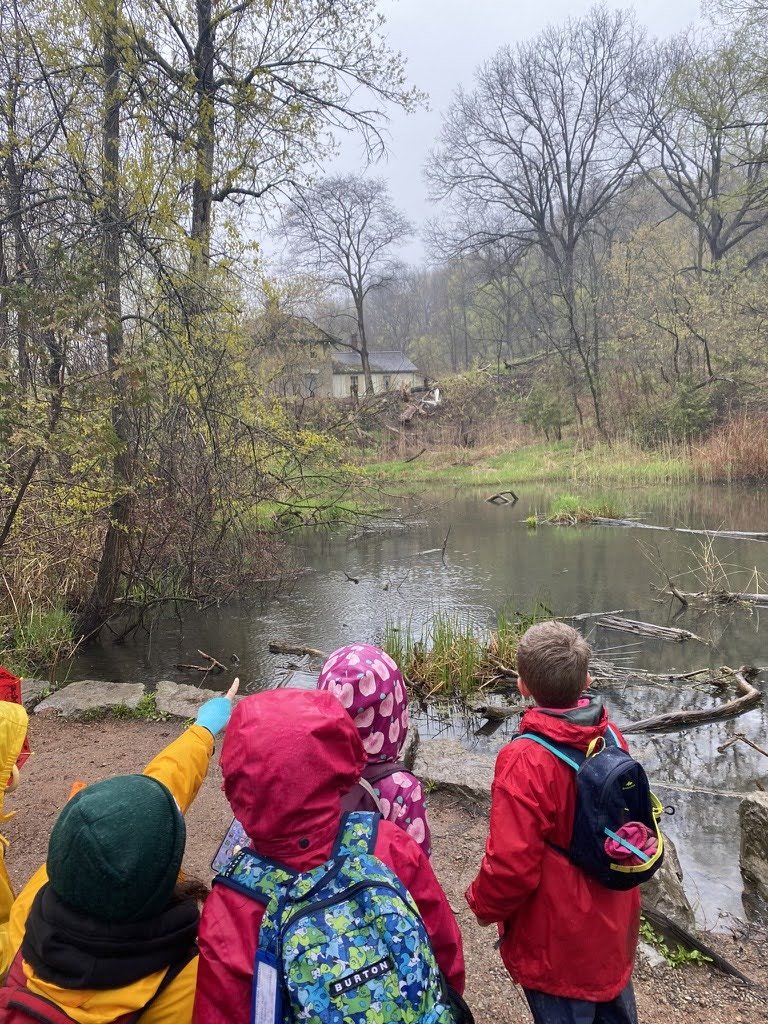
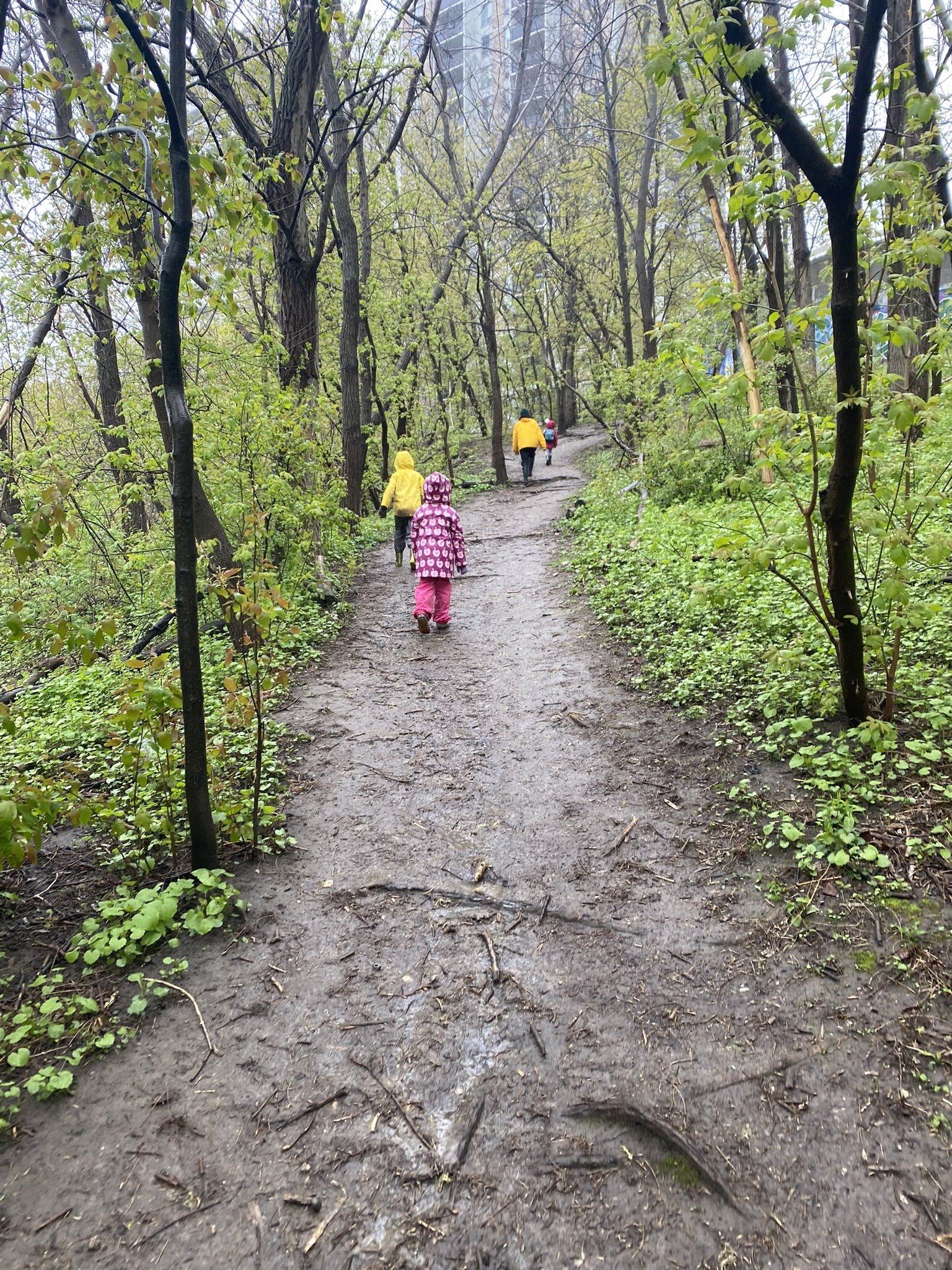
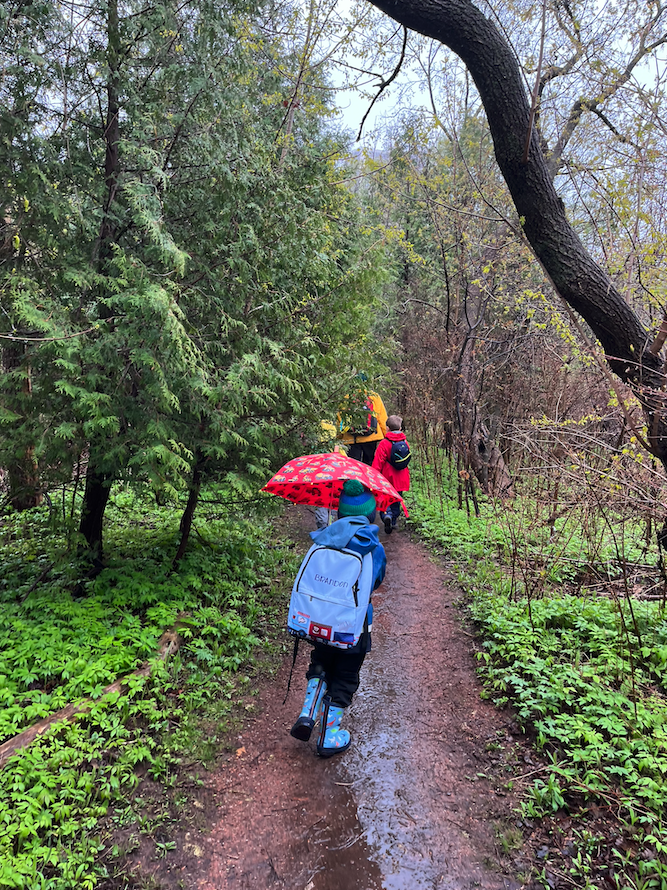
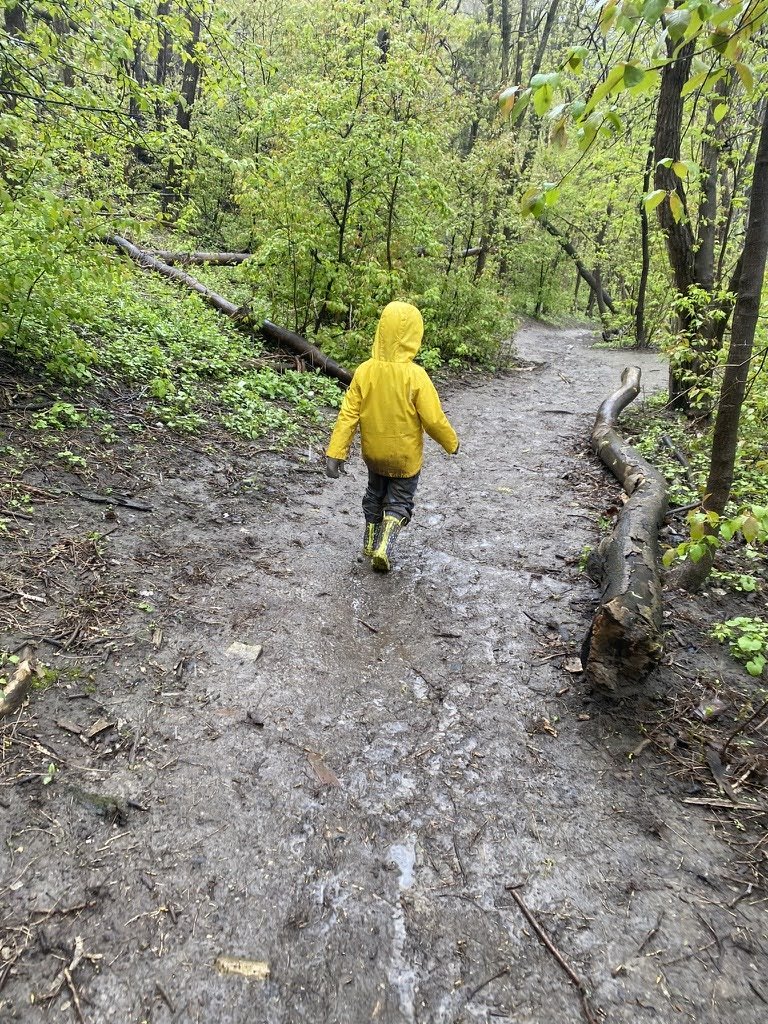
For many, the month of May symbolizes revitalization as the new flowers bloom and the grass becomes green again. After a month of rain, May eventually brings more sunshine and warmth to our doorsteps and coaxes us to venture outdoors. This often leads to a change in mood as we break through the winter blues and become excited for what spring and summer have to offer. The first week of May is a reminder of this since May 1-7 marks Mental Health Week and wraps up on the 7th with National Child and Youth Mental Health Day. So, wherever you or your loved ones are in your mental health journeys, let’s explore some of the ways that incorporating nature into your routine can help kickstart your mental wellbeing this spring.
Time spent in nature is such an important part of life for growing bodies and minds. For kids, May marks the second last month of the school year, just before summer break begins. With all this extra free time, it is the perfect opportunity to get outside and enjoy the outdoors. Research shows that being in nature has many positive impacts on mental health for children including reduced stress and anger (Sobko et al., 2020), fewer emotional difficulties (Sobko et al., 2018), reduced hyperactivity for children with ADHD (Sobko et al., 2018), improved self-concept (Mann et al., 2022), and increased wellbeing (Puhakka et al., 2019). At Larchwood OT, we often see mental health challenges in children present as anxiety, fear of situations or being themselves, perfectionism, and people pleasing. If any of these resonate with you, here are some ideas for encouraging your child (and yourself!) to get their fill of time spent outdoors in the coming weeks and months:
Go on a family hike – This has been shown to foster a here-and-now presence for families that can strengthen their relationship (Baklien et al., 2016)
Play in parks and natural areas – This gives kids the opportunity to develop new skills and resiliency when they come across unexpected situations that they wouldn’t otherwise experience in school or indoors (Mainella et al., 2011)
Create a biodiverse backyard or patio – This provides your child with a multi-sensory environment that will spark creative play and diversify the activities they engage in (Puhakka et al., 2019). Encouraging them to take care of this space by giving them roles or responsibilities like watering plants regularly will build their sense of connection with nature and their autonomy!
Sign up for a summer nature camp – If you’re looking for more structured time outdoors, check out Davis OT’s Larchwood Farm Nature Camp in Markdale, Ontario! Registration is open for Summer 2023 and each day is packed full of nature-based learning activities. Or, if you’re a Toronto local, check out our Handwriting in Nature mini-camp which runs from August 21-23 from 9am-11am in Riverdale Park East.
Most importantly, this week is a reminder that mental health ebbs and flows and that it’s okay if you or your child haven’t been feeling all that great. If you’re interested in exploring mental health resources, from local mental health support to tips for coping with stress to virtual mental health programs and apps, check out the city of Toronto’s webpage: https://www.toronto.ca/community-people/health-wellness-care/health-programs-advice/mental-health-resources/. Please remember, if you or someone you care for is experiencing a mental health emergency or medical crisis, call 911.
You are the sky. Everything else is just the weather - Pema Chodron.
Hello! My name is Wagma and I'm a second year occupational therapy student at Western University, on an exciting journey (and a period of transition) where I am beginning my last placement right here at Davis Occupational Therapy! I am so excited to embark on this new journey from being a student to a practicing professional soon. I am most excited to expand my learning through the mindfulness group tailored for adults with ADHD by taking on the role of a co-facilitator with Heather and I believe that my passion lies right here and am confident that I will grow and learn more about myself and my values during my time here.
Grateful to be here :)
A little about me, I am a huge mental health advocate! As an individual who has faced unique challenges to her own mental health for more than a year or so I have had many personal experiences of finding what works best for me. A few of those things has been practicing mindfulness and practicing daily gratitude. I noticed that when I started to become grateful for the little things in life and I started to practice being in the present through mindful activities that the progress I was making every day started to really add up. I don't consider myself an expert in mindfulness since this is just my personal journey but I see myself contributing to other people's journey whether that may be a journey with a mental health challenge or not.
“The only way we have of influencing the future is to own the present, however we find it”
I love spending time outdoors, connecting with nature, and focusing on how to connect my mind, body, and breath to the external environment. As we approach the warmer weather, you can catch me doing breath work in my backyard or curled up with a good book. I love working with all ages, whether that be kids or adults, because the benefits of nature and mindfulness can benefit everyone. Learning how to become mindful is such an important skill to have especially when there are so many distractions in today's world. I cannot wait to see how these skills flourish in the mindfulness group and how I can contribute to this trajectory of change.
“believing in yourself and trusting that you are on the right path, and not being in doubt by following the myriad footpaths of those wandering in every direction”
The Earth has music for those who listen. - Shakespeare
Magic in every season
My name is Anna, and I am a 2nd-year student in the MSc program in Occupational Therapy and Occupational Science at the University of Toronto. If I am not studying or working in clinical placements like the one at Larchwood/Davis OT, you can find me chasing around or snuggling with my three kids, Ryan (8), Emilia (6), and Anika (4), doing some form of yoga or going on long walks.
Over the last four weeks, I have had the pleasure of helping with various tasks at Larchwood/Davis OT, including shadowing and working alongside our outstanding therapists. Specifically, I have been supporting Michelle and her Explorers group on Saturday mornings and shadowing client sessions for both adults and kids. I also assist Alanna in organizing the research project Larchwood OT is currently conducting, in which we explore the impact of our 8-week nature-based group program on social-emotional change in children.
Thank you to all parents willing to share their experiences through our pre- and post-questionnaires. Research like this, and individuals' willingness to share their perspectives, will inform clinical best practices and standards, recommendations for interventions, insurance coverage, and much more. So, thank you for contributing to this vital work and helping us advocate for better practices to support kids and their families.
With a background in education (specifically dyslexia therapy and post-secondary education), I decided to pursue my OT journey during the pandemic. While homeschooling my own children and volunteering in the community, I realized how impactful OT work can be and that I have a strong desire to help both kids and adults achieve goals that are most meaningful to them.
During this time, I also learned to appreciate nature's incredibly positive effect on my and my kids' mental and physical health. Understanding that learning in the outdoors requires little props and zero flashy toys (just proper clothing!) is quite liberating!
On my own journey of becoming a mother, I always found comfort, strength, and balance in outdoor environments and have come to appreciate a mindful way of living. Seeing the kids at Larchwood OT engage in risky play, being brave, curious, and comfortable in the (sometimes) uncomfortable, has been incredible. I am thrilled I get to experience this fieldwork placement and cannot wait to see what the next four weeks will bring!
Adventure is out there!
Hello! My name is Abby (she/her) and I’m currently in my second year of occupational therapy at the University of Toronto. As a new student for Davis OT, you’ll find me participating in our exciting weekend Nature OT groups in Toronto, posting on the Davis OT and Larchwood social media pages, and working on projects behind-the-scenes with my student peer, Anna. One of the projects I will be contributing to is revamping the Larchwood Summer Camp curriculum to include as many nature-based activities as possible!
When I saw the opportunity to complete my fieldwork placement for Davis OT and assist with developing content for the Larchwood Farm Nature Camp, I couldn’t resist! The Larchwood Farm Nature Camp is such a unique summer day camp that provides the perfect setting for children with various physical, cognitive, social, and emotional abilities to build many types of skills through nature therapy. It is so meaningful for me to be able to research and design activities that are inclusive and support the campers’ learning and development while also fostering their appreciation for nature. I can’t wait to hear all about the fun experiences they have this year once camp is in session!
I’m thankful to have the opportunity to support such a talented and creative team of OTs and volunteers at Davis OT for this placement. I’ve always loved being in nature and am a strong supporter of the benefits that time outdoors has on mental health and wellbeing. As a kid, I spent much of my summers outdoors with my family on camping trips, going on hikes, playing sports, and exploring the local flora and fauna. As an adult, you’ll still find me spending most of my summer outdoors with family and friends!
I moved to Toronto in 2021 for school after spending several years living in Waterloo while completing a degree in Psychology. Prior to Waterloo and Toronto, I lived in a small town in southern Ontario where I spent a lot of my time swimming in my backyard, climbing trees, making campfires, catching tadpoles, and skating on nearby creeks. While growing up, I participated in, volunteered for, and worked at various summer camps where I was able to share my passion for the outdoors with other like-minded kids and adults. I’m thrilled to be spending the next couple of months learning more about the intersection between nature and occupational therapy while working with such a great community of kids, parents, and adults!


